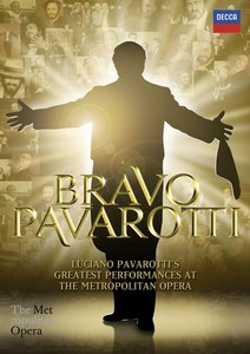October 31, 2011
German tenor thrills Met audience in solo recital
By Mike Silverman [AP, 31 October 2011]
He’s already thrilled Metropolitan Opera audiences with his exceptional vocal powers in such large-scale works as Puccini’s “Tosca,’’ Bizet’s “Carmen’’ and Wagner’s “Die Walkuere.’’
October 27, 2011
Renée Fleming and Dmitri Hvorostovsky: A Musical Odyssey in St. Petersburg
Would it really have been unacceptable to call the program “A Musical Travelogue in St. Petersburg”? There are no adventures with sirens or one-eyed giants, nor is there any sense of homecoming and redemption. Instead, soprano Fleming (Hvorostovsky apparently otherwise engaged) walks through some of the more appealing tourist locations of the city, in three segments that take up about 20 minutes of the main program’s 90-minute running time. At least Decca provides an additional four musical selections for the DVD release.
Putting aside persnickety complaints about language, the DVD is very enjoyable. It gets off to a great start by skipping introductions and immediately joining Renée and Dmitri in front of the State Hermitage orchestra and conductor Constantine Orbelian. Credits roll as the singers launch into the fourth act duet of Il Trovatore’s Leonora and Di Luna. Other than Violetta and Desdemona, Verdi hasn’t played a big part in Ms. Fleming’s career, so it’s fairly surprising how well she does in this scene. Hvorostovsky has sung the Count many times, and in this smaller hall, he is able to bring all of his skill to the performance without having to push as he would in a larger venue. Next, after 10 minutes of Renée guiding us through the Winter Palace, we return to the concert and an extended scene from Simon Boccanegra. A briefer travelogue is followed by several Russian songs, with Olga Kern at the piano. This is Hvorostovsky’s home territory, of course, and he shines; Ms. Fleming looks and sounds ravishing.
Another travelogue section precedes the return of the orchestra for selections from three Tchaikovsky operas, listed in the booklet as Pique Dame, Oprichnik, and the reliable Eugene Onegin. Hvorostovsky sings Yeletzki’s aria handsomely as expected, and the rare opera’s aria for Renée is quite beautiful. Then the pair performs the final scene of Onegin with a potent mixture of elegance and dramatic force.
The bonus tracks are all worthy and undoubtedly only edited out of the main program only for reasons of timing (the main program was offered on PBS in the Great Performances series). Dmitri sings Hamlet’s drinking song from the Ambroise Thomas opera and a rare and very entertaining Anton Rubinstein number. Ms. Fleming gives us her creamy “Casta Diva” and Lisa’s first act aria from Pique Dame.
The Decca set has rudimentary packaging, but the performance itself is classy, and as the travelogue sections are separately tracked, they can easily be skipped on repeat viewings. If one doesn't expect the rollicking adventure of a true odyssey, this set should prove to be high-quality musical entertainment.
Chris Mullins
image=http://www.operatoday.com/0743383.png
image_description=Decca 0440 074 3383 6 GH [DVD]
product=yes
product_title=Renée Fleming and Dmitri Hvorostovsky: A Musical Odyssey in St. Petersburg
product_by=Renée Fleming, soprano. Dmitri Hvorostovsky, baritone. State Hermitage Orchestra. Conductor: Constantine Orbelian. Directed for video by Brian Large.
product_id=Decca 0440 074 3383 6 GH [DVD]
price=$27.99
product_url=http://www.arkivmusic.com/classical/album.jsp?album_id=509305
Pavarotti at the Metropolitan Opera
The Metropolitan has recently re-released on DVD the 1978 telecast of Pavarotti’s first Cavaradossi at the Metropolitan. The greater testimony to the ongoing fame of this tenor is a separate Decca release, in tandem with the Metropolitan Opera, called “Bravo Pavarotti.” Only a singer who has reached a very rare level of popularity gets the distinction (if that’s the word) of an entire DVD devoted to clips of aria performances from various telecasts, with absolutely no other content. Decca and the Metropolitan clearly believe there is a market out there, an audience that wants a disc they can put on whenever they just want to bathe in the warm beautify of Pavarotti’s tone and his joyful stage presence.
The DVD consists of 14 excerpts from Pavarotti’s repertoire at the Metropolitan — entirely Italian: Verdi, Donizetti, Puccini and Leoncavallo, with the interesting addition of his restrained but effective appearance in Mozart’s Idomeneo. The video quality varies, with some of the older clips lacking vibrancy, but Pavarotti’s connection to the audience can be felt at almost every moment. Indeed, part of the length of this relatively short DVD (about 90 minutes) comes from extended shots of the tenor, arms wide, eyes initially closed, basking in the extended ovations he came to expect. Are these performances flawless? Of course not. The high notes of both Che gelida manina and La donna è mobile both show his technical skill, as in both cases the note is initially not there for him. Pavarotti adjusts and holds on, where a lesser sing might have cut the note short.
Although not the most convincing actor, these clips do show him as an engaged performer — but then most of these are from his golden middle period, before he began to earn himself a reputation for carelessness and indifference. The close-ups are fascinating, however, for that face, so joyful and alive during the ovations, is a true singer’s mask when vocalizing. Pavarotti’s eyes focus on some distant spot, as he produces his sound and prepares for whatever musical challenge the next phrase may bring. The most illustrative — and amusing — example of this is the Rigoletto quartet, which Pavarotti sings with the Maddelena of Isola Jones, a strikingly beautiful woman with ample — and exposed — cleavage. While singing, Pavarotti is entirely professional, but when he has the chance, he can’t help but very realistically portray the Duke’s leering enjoyment of his evening’s conquest.
So is “Bravo Pavarotti” for anyone but the most diehard Pavarotti fan? Probably not. The brief booklet essay merely runs through some basic information on each performance, and otherwise there is nothing in the package that one couldn’t put together for oneself fairly easily.
That complete 1978 Tosca is a different matter. Conducted with fervor by a very young James Conlon, this Tosca is a handsome example of the Met at its tasteful, traditional best. This is the Tito Gobbi production, and among the three excellent bonus features is a conversation between this performance’s Scarpia, Cornell MacNeil, and Gobbi. We also get a chance to watch James Levine and Conlon try to outdo each other in insightful comments about Puccini’s score. The best of the three is a short rehearsal sequence with Conlon and a pianist leading Shirley Verrett, the Tosca, and Pavarotti through the act three duet. Conlon proves himself to be calm and psychologically astute, as he supports a somewhat needy Verrett and keeps Pavarotti from getting bored.
Pavarotti is in glorious voice throughout (the two big arias are part of the Bravo Pavarotti set), and MacNeil, though late in his career, has the experience and craftsmanship to keep mostly disguised the voice’s tendency to sag in pitch. Verrett, in unappealing light make-up, offers little that is original in her Tosca, but she inhabits the role with grace and passion. Extended passages start to show some stress on her voice (she was known primarily for mezzo repertory), but she has enough of a success to earn a shower of torn program confetti at curtain call.
Tosca was always planned to be the opera Pavarotti would perform in for his final complete performance at the Metropolitan. A year or two before that happened, Pavarotti had to cancel a run. He was replaced in one performance at the last moment by a very young Salvatore Licitra, who earned glowing reviews that suggested he might be the “next Pavarotti.” Alas, Licitra’s career, while substantial, did not support that characterization, and even more sadly, Licitra died this year in an accident. Other singers may come along and be alarmed to find themselves declared “the next Pavarotti,” but everyone knows there will be no such singer. And with Decca holding onto its legacy of recorded Pavarotti performances, we won’t be without the real Pavarotti anyway.
Chris Mullins
image=http://www.operatoday.com/0743410.png
image_description=Decca 0440 074 3410 9 DH [DVD]
product=yes
product_title=Giacomo Puccini: Tosca
product_by=Tosca: Shirley Verrett; Cavaradossi: Luciano Pavarotti; Scarpia: Cornell MacNeil. The Metropolitan Opera Orchestra. Conductor: James Conlon. Director: Tito Gobbi. Metropolitan Opera, December 1978.
product_id=Decca 0440 074 3410 9 DH [DVD]
price=$24.99
product_url=http://www.arkivmusic.com/classical/Drilldown?name_id1=9762&name_role1=1&comp_id=2345&genre=33&bcorder=195&name_id=53434&name_role=3
Bravo Pavarotti: Luciano Pavarotti’s Greatest Performances at the Metropolitan Opera
Various artists
Decca DVD B0014805-09
Tosca
Music: Giacomo Puccini
Libretto: Giuseppe Giacosa and Luigi Illica
Metropolitan Opera, December 1978
Director: Tito Gobbi
The Metropolitan Opera Orchestra
Conductor: James Conlon
Tosca: Shirley Verrett
Cavaradossi: Luciano Pavarotti
Scarpia: Cornell MacNeil
Decca DVD B0014793-09
Carmen returns to the Opéra Comique
After all, any conductor who doesn’t follow the practice would seem to be tagged as “historically ignorant.”
At its start some decades ago, the “HIP” movement focused on baroque and early classical era music. It has since branched out, and that branch is impressively extended with the recent DVD of Sir John Eliot Gardiner conducting his Orchestre Révolutionnaire et Romantique at the Opéra Comique in an historically informed performance of Georges Bizet’s Carmen. Besides employing instruments of the era, this production aims for authenticity from the ground up — or “the stage” up. For Carmen debuted at the Opéra Comique, infamously receiving a less than ideal reception that many conjecture added to the stress which culminated in the composer’s early death from heart disease. Stage director Adrian Noble strives to freshen the action while keeping to a libretto-bound conception of the story and characters. This is still, therefore, a Carmen who sits with legs splayed, and who sashays with one hand on a hip. That said, Noble does have his Don José plant a kiss on Micaela in act one that goes beyond the usual pallid interaction.
Set and costume designer Mark Thompson, however, seems of two minds. The costumes are very traditional, though nicely done — almost everything is in a spectrum of light beige through dark brown, and the clothes look truly worn. In so many a Carmen, everyone looks as if the local dry cleaner is working overtime. Thompson’s uniset, however, surely looks nothing like whatever the Opéra Comique used in 1875. Act three, for example, gives only the barest indication of a mountain pass. Instead, we have a sort of elevated walkway at the rear which slopes to stage level, and a circular platform just off mid-stage. Apparently the cigarette factory is subterranean, as the girls take their break by clambering out of the platform. For act 4, Noble and Thompson clear the stage for the intense action of the last scene.
There are moments in the recorded performance where one can almost imagine, however, that one is watching — if not the authentic first performance — something rawer and more authentic than many another recorded Carmen. Sir John and the artistic team use an edited version of the score (by one Richard Lanhman-Smith) that has spoken dialogue, as Bizet originally intended. And under Noble’s direction, a committed cast delivers strong performances — honest and stripped-down to essentials. Anna Caterina Antonacci’s Carmen has already been recorded in an acclaimed Covent Garden performance opposite Jonas Kaufmann. Her comfort in the role allows her to perform even the most stereotypical gestures and movements with relaxed conviction. Oddly, the only times that her singing reflects any discomfort with the role is at the higher range — which one might think unusual for a singer with a career as a soprano. Perhaps in adjusting her voice for the reliance on the middle range, Antonacci loses a bit of security at the top. It’s a very minor compromise in an otherwise strong performance.
Her Don José does a fine job right up until his big second act aria and continues to be fine thereafter. But Andrew Richards is not able to deliver the “Flower Song” with the security and confidence the moment requires. It’s all the more unfortunate as his Don José is so believable — a man of modest attraction, overwhelmed by the chance to share the passion of Carmen, and then devastated when it is withdrawn. The supporting cast makes more routine impressions, with Anne-Catherine Gillet giving us a Micaela even mousier than usual, and Nicolas Cavallier too smug for his own good as Escamillo.
As for Gardiner and his orchestra, they often play fast, as one might expect, and there are patches of roughness than either attest to the authenticity of the performance or suggest a deaf ear to musical sophistication — depending on one’s attitude towards HIP. Gardiner’s most regrettable choice is the Nehru jacket. Un-HIP.
The packaging is remarkably handsome but not without compromises. Your reviewer prefers removable booklets to one bound to the spine. The two discs are visually nearly identical, with text almost impossible to read. Figuring out how to dislodge the discs from the casing also took more of your reviewer’s ingenuity than he would have liked. The bonus feature is a rather routine 20 minute set of interviews, but as the booklet has nothing but credits and synopsis, anyone wanting a little more insight into the performance will have to view it.
Not a “hip” Carmen, then, but this HIP Carmen does have historical appeal and a strong performance of the title role.
Chris Mullins
image=http://www.operatoday.com/FRA_Carmen.png image_description=FRA Musica FRA 004 product=yes product_title=Georges Bizet: Carmen product_by=Carmen: Anna Caterina Antonacci; Don José: Andrew Richards; Escamillo: Nicolas Cavallier. Orchestre Révolutionnaire et Romantique. The Monteverdi Choir. Director: Adrian Noble. Conductor: Sir John Eliot Gardiner. Opéra Comique, June 2009. product_id=FRA Musica FRA 004 [2DVDs] price=$37.49 product_url=http://www.arkivmusic.com/classical/Drilldown?name_id1=1141&name_role1=1&comp_id=479&genre=33&bcorder=195&label_id=12271Béatrice et Bénédict, Opera Boston
It is a question that Berlioz, to his frustration, never quite answered. In his youth, bel canto held the stage, and the tone was set by Rossini and Bellini; by his maturity, grand opera and its rather different conventions had taken over. How was a composer of the highest aspirations to structure a work that was to give rein to experience and perception? The reliable but chilly structures of the Baroque and the da capo aria, with its implied assurance that the world was to return to the given social order, just as the singer was bound to return to the first melody, were not going to prove satisfactory; the very different example of the opera-comique in France, with its bumptious mixture of popular entertainment and cultivated composition was, for a composer like Berlioz, little inspiration. The failures of Schubert’s Fierrabras and Schumann’s Genoveva as dramatic vehicles functioned as a kind of warning, and the silence of Brahms — his profound disinterest in writing for the stage — was instructive. Only Weber’s Freischutz, and, to a lesser extent, his Euryanthe and Oberon, established and retained places on the international stage, and in the allegiances of popular and learned auditors.
By the time Berlioz wrote Béatrice et Bénédict, he had endured a lifetime of frustration and misunderstanding in opera. No composer has ever loved drama more, or more instinctively, than Berlioz, yet he had the greatest difficulties — many self-imposed — in creating vehicles that played as drama. Benvenuto Cellini is a mess of color and action; La Damnation de Faust, despite recent efforts by the Metropolitan Opera, is almost inert dramatically; Les Troyens is a magnificent masterpiece, but long, unwieldy, and intermittently static. Beatrice and Benedict, which he wrote in the early 1860s, is an odd creation by almost any standard. The story, extracted by Berlioz himself from Shakespeare’s Much Ado About Nothing, is a light, almost eventless romantic comedy. The heart of Much Ado is a fundamentally misogynistic tale of deception and wronged virtue: Claudio is suborned by Don John into believing that his betrothed, Hero, has been untrue to him. These unhappy lovers, on their winding way back to the altar, are accompanied by the low-comedy antics of the local constabulary, and, most of all, by Hero’s cousin Beatrice and Claudio’s boon companion, Benedick, whose repeated slanging matches signal, to everyone but themselves, a deep underlying sexual tension and romantic affection. These two have long since crowded the disquieting principal plot, which is a story only an academic could love — as long ago as the 1630s, King Charles I titled his copy of the play Beatrice and Benedict. Berlioz simply discards all the pesky business — gone Don John, gone denunciations at the altar, gone Dogberry and the antics of the police; welcome a slight and forgettable bit of new business with a newly-devised character, the music-master Somarone (“Big Ass”). The trouble here is that without even a hint of shadow — all Claudio and Hero do is to egg their friends on, while the nuptials approach — there is very little narrative drive. It does not come as much of a surprise to learn that Berlioz planned the work as a one-act opera, and extended it; the music of the two-act version is consistently rewarding, but dramatically almost as inert as his Faust. Berlioz’s thinking here is orchestral, and almost symphonic — Béatrice et Bénédict is, arguably, a symphony or tone poem on themes from Shakespeare, with voices. As such, it is among Berlioz’s most appealing works: the duet-nocturne that closes the first Act, perfectly performed by Opera Boston, is arguably one of the most beautiful episodes in all of opera.
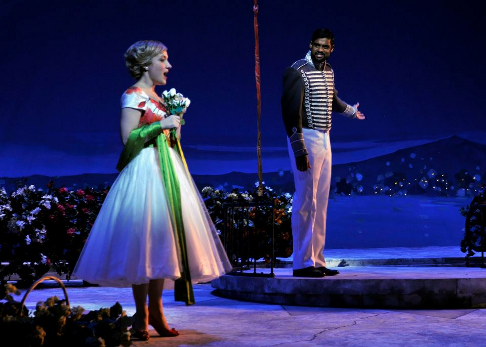 Julie Boulianne as Béatrice and Sean Panikkar as Bénédict [Photo courtesy of Opera Boston]
Julie Boulianne as Béatrice and Sean Panikkar as Bénédict [Photo courtesy of Opera Boston]
For all his superior mastery of more complex forms and ideas, Beethoven, Berlioz’s great musical model, could only wish he had written ten more beautiful minutes. Opera Boston, a laudable champion of the neglected and under-heard in opera, has essayed a fluent, elegant staging of Berlioz’s last stage work. The setting is still Sicily — or, that sort of neverland Shakespeare always evokes in his comedies — but resituated in a high-toned 1950s, complete with puffed skirts, bobs, and up-dos — you almost expect a poodle-skirt to sashay in. Designer Robert Perdziola’s set design is equally stylish — the capolavoro is perhaps the lifting of set’s back wall, mottle-painted to suggest aging stucco, to reveal a heart-stopping night sky and distant harbor. As Beatrice, Julie Boulianne has a fine mezzo-soprano voice, a little hard-toned in the upper reaches; Sean Panikkar as Benedict lacked a little polish and finish in tone. Heather Buck’s Hero was excellent at the top and bottom of her register, but a little elusive at times in the middle. Kelley O’Connor as Ursule almost stole the evening, with an arresting, dark-colored low-mezzo voice. Gil Rose’s orchestra offered a seamless and idiomatic reading of Berlioz’s tuneful score. Director David Kneuss, a long-time advocate of the work, decided on an odd hybridization of languages and styles — the sung score was heard in Berlioz’s French, the dialogue in English, in an adaptation that mixed Shakespeare, Berlioz’s own additions for the French-language premere in 1863, and what was apparently some of Kneuss’ own work. Although the result was not as jarring as might have been feared, why not go all the way in any one of these directions? Shakespeare, with minimal alterations? modern English for everything? French for all? Kneuss also did not entirely solve Berlioz’s dramaturgical problems, perhaps a thankless task on the best of days. Principals and chorus were frequently perfectly stationary in moments that, musically and dramatically, suggest movement (the opening of Act I; the drinking song in Act II) — but then, to be fair, Berlioz always had peculiar ideas about what constituted a party.
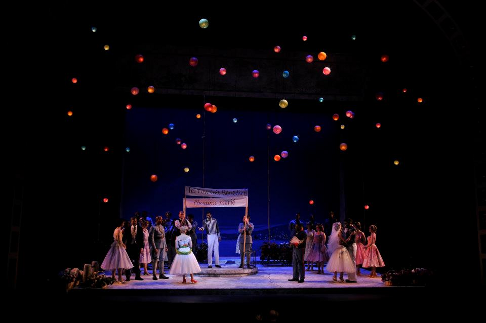 Finale [Photo courtesy of Opera Boston]
Finale [Photo courtesy of Opera Boston]
Beatrice and Benedict was not quite his last work — the Memoirs were to follow — but is arguably his last musical work of any importance. Like Verdi long after him, he said farewell to the stage, and to some degree to music, with comedy — and comedy from Shakespeare, at that. He lacked Verdi’s Boito — he had no librettist of genius to help shape the drama, and provide a loving but stern pair of eyes to look over the work. Why this work — and why this curious selection from Much Ado? Shakespeare had long been both his inspiration and his undoing; it was through Shakespeare that he found himself as a composer of genius, and it was through Shakespeare that he met Harriet Smithson, the English actress he loved and married. Their relationship declined into mutual loathing and recrimination — but in this bagatelle on Shakespearean themes, we see a merrily quarrelling couple, Beatrice and Benedict, whose loving combat never degrades into hatred. They are Hector and Harriet, without the depredations of age or misfortune. When it premiered, Verdi’s Forza del Destino opened in Imperial Russia; Offenbach’s Belle Helene was in preparation, and Meyerbeer’s Africaine was being completed; most of all, Wagner’s Walkure had just appeared at Bayreuth. Aesthetics very different from Berlioz’s, although perhaps similar in ambition, had arisen; yet this last and most polished and mature work from the pen of Berlioz deserved and deserves to be heard. Opera Boston’s commendable production, with its polished style and fine young singers, goes a long way toward keeping Berlioz’s music fresh and living for contemporary audiences.
Graham Christian
image=http://www.operatoday.com/Much_Ado_Quarto.png image_description=Title page of the first quarto of Much Ado About Nothing by Shakespeare [Source: Wikipedia] product=yes product_title=Hector Berlioz: Béatrice et Bénédict product_by=Click here for cast and production information. product_id=Above: Title page of the first quarto of Much Ado About Nothing by Shakespeare [Source: Wikipedia]October 26, 2011
Don Giovanni, Metropolitan Opera
Supposedly, when the opera was performed the following evening, the ink was still wet on the pages.
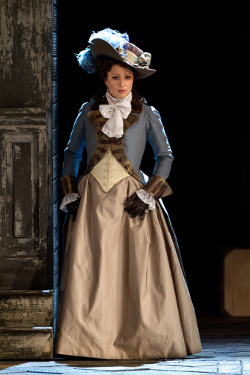 Barbara Frittoli as Donna Elvira
Barbara Frittoli as Donna Elvira
The finished product is a marvel of composition. After the opening, two ferocious minor chords, what follows is a depiction of hell: the perfect beginning to an opera whose full title is Don Giovanni, or The Punished Miscreant. When the Met’s new principal conductor, Fabio Luisi, conducted the new production of Don Giovanni on Saturday, October 22nd, he executed the beginning minor chords of the overture with startling accuracy. However, in the following section, in which Mozart depicts hell, he seemed a tad lackluster. Unfortunately, this was a sad harbinger of what was to come, not just from the pit, but from the stage as well.
So what went wrong? My diagnosis is that the Met’s new production, directed by acclaimed Broadway director Michael Grandage, fell victim to the politics of the Peter Gelb regime. As a director who is unfamiliar to opera, Grandage fits well into Gelb’s scheme of operatic rejuvenation, for the purposes of demonstrating to the public that “opera is not just great music, but great theater as well.” To be fair, Mr. Grandage’s work can be breathtaking. A recent Broadway run of Hamlet, starring Jude Law, was a wonderful night at the theater. Unfortunately, Mr. Grandage’s productions function mainly as vehicles for the performers. Had Hamlet not starred the dynamic Mr. Law, it might have come up flat. This is what happened here.
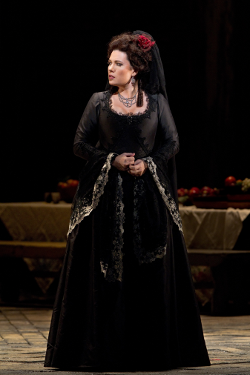 Marina Rebeka as Donna Anna
Marina Rebeka as Donna Anna
The real problem with this production, therefore, can be seen as a trick of fate. Under normal circumstances, the title rascal would have been played by baritone Mariusz Kwiecien and James Levine would have been in the pit. As it happened, both Mr. Kwiecien and Mr. Levine were indisposed, so the Finnish baritone Peter Mattei had to be pulled from The Barber of Seville where he was singing Figaro, and Fabio Luisi stepped in, yet again at the last minute, for Mr. Levine.
While an amazing Figaro, Mr. Mattei’s Giovanni was a caricature of the great villain. To be sure, Don Giovanni is an opera buffa, but it is less a bubbling comedy, like Rossini’s Barber, and more a dark comedy with far-reaching political undertones. The oversexed nobleman of the title is supposed to make you laugh, but each laugh is supposed to hurt. Mattei’s Giovanni lacked the essential component of volatility that Mozart so desperately wanted. That said, he sang well. His “Deh vieni alla finestra” was a joy to hear, but despite the masterful singing, this aria, just like the majority of the performance, lacked emotional substance.
As Leporello, Luca Pisaroni was magnificent. He played Giovanni’s servant as a sardonic commentator on the action. His performance as the valet made me hope that he would one day attempt the Don himself. Among the men, other standouts include Ramón Vargas, who gave a wonderfully sung and surprisingly masterful performance as Don Ottavio. He was far from the epitome of inactivity of other productions. Joshua Bloom gave an excellent turn as Masetto, and Štefan Kocán was a marvelously unstable and threatening Commendatore.
Of the three women, Mojca Erdmann was a stylish Zerlina. She certainly has the technique to sing Mozart, however her character portrayal of the wily peasant girl was a little flat. The highlight of her performance was “Vedrai carino.” It showcased her ability as an actress while at the same time making one wish the rest of her performance could have been as good. Marina Rebeka was a thrilling Donna Anna. The highlight of her performance was “Or sai che l’onore.” It is customary to portray Donna Anna as a strong character, only limited by the accident of being born a woman. However, here she didn’t just scold Don Ottavio. Had the aria been longer, she might have eaten him alive.
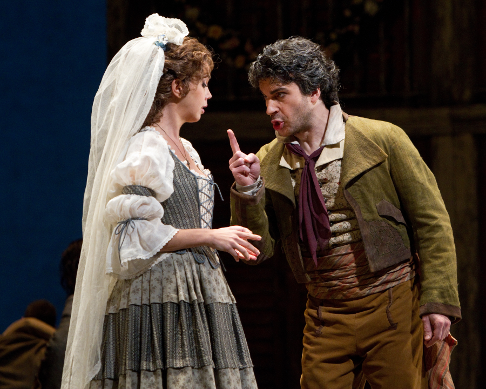 Mojca Erdmann as Zerlina and Joshua Bloom as Masetto
Mojca Erdmann as Zerlina and Joshua Bloom as Masetto
The crowning achievement of this performance was Barbara Frittoli. For better or worse, she became the focal point of the opera. She took a well-known facet of the character, her ambivalent mix of revulsion and love for Giovanni, and explored it to the utmost degree. Unlike other Elviras, who between acts one and two seem to magically change from loathing to adoration for the Don, both facets of her character were present from the beginning.
Critics have maligned this production for its set, which consists of a wall of decrepit-looking shuttered balconies. They scoff at its so-called “Advent calendar” design. In my opinion, the design is not the flaw here. What is an issue is the blocking. Throughout the opera, certain characters on the ground interact with those standing on balconies. This creates an uncomfortable lack of chemistry in an opera that is supposed to sizzle with eroticism. Yet even when all the characters are standing together on the ground, there was confusion in their interactions. For instance, Donna Anna was not present for Don Ottavio’s rendition of “Il mio Tesoro.” As a consequence, Mr. Vargas had to sing of his love for Donna Anna to everyone else but Donna Anna.
Instead, Mr. Vargas focused on Donna Elvira. While this strengthened the idea that Elvira is engaged in a neverending search for love, this directorial faux pas made me wonder if Elvira was really the title character of this production. There were some instances of genius. Don Giovanni removed Zerlina’s veil just before “La ci darem la mano.” A subconscious nod toward his desire to take her virginity, perhaps? Also, Elvira was ravished on the dining room table by a Giovanni who was literally blinded to fate during his last meal on Earth.
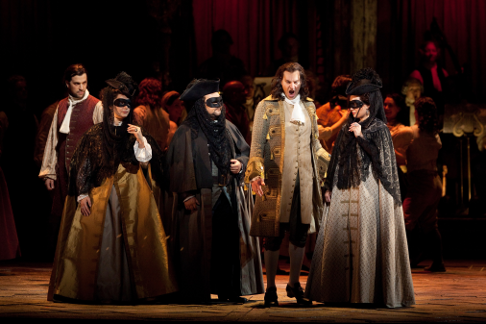 Luca Pisaroni as Leporello, Barbara Frittoli as Donna Elvira, Ramón Vargas as Don Ottavio, Peter Mattei as Don Giovanni, and Marina Rebeka as Donna Anna
Luca Pisaroni as Leporello, Barbara Frittoli as Donna Elvira, Ramón Vargas as Don Ottavio, Peter Mattei as Don Giovanni, and Marina Rebeka as Donna Anna
However, such inspiration was fleeting. At the end, when all the characters sing of their need to put their lives back in order, I was left wondering, “Was there any real threat to begin with?” The desire to reinvigorate the public’s interest in opera with ubertheatrical productions is a noble endeavor, but if the performance doesn’t at least acknowledge what originally excited the composer, how can we be sure a modern day public will be interested?
Gregory Moomjy
image=http://www.operatoday.com/GIOVANNI-Pisaroni-Mattei6582.png image_description=Luca Pisaroni as Leporello and Peter Mattei as Don Giovanni [Photo by Marty Sohl/Metropolitan Opera] product=yes product_title=W. A. Mozart: Don Giovanni product_by=Donna Anna: Marina Rebeka; Donna Elvira: Barbara Frittoli; Zerlina: Mojca Erdmann; Don Ottavio: Ramón Vargas; Don Giovanni: Peter Mattei; Leporello: Luca Pisaroni; Masetto: Joshua Bloom; The Commendatore: Stefan Kocán. The Metropolitan Opera. Conductor: Fabio Luisi. product_id=Above: Luca Pisaroni as Leporello and Peter Mattei as Don GiovanniPhotos by Marty Sohl/Metropolitan Opera
Delayed by Injury, Giovanni Still Arrives
By Anthony Tommasini [NY Times, 26 October 2011]
The Polish baritone Mariusz Kwiecien looked nimble on his feet, sang robustly and threw himself into the title role of Mozart’s “Don Giovanni” at the Metropolitan Opera on Tuesday night in the new production by the director Michael Grandage. Whatever one’s take on Mr. Kwiecien’s portrayal of a role he considers his calling card, his performance was a triumph of physical rehabilitation and artistic determination.
A Portrait of Manon — Young Artrists at the Royal Opera House
All members of the Royal Opera House Young Artists scheme are professionals, not students, and have extensive experience even before they come, as former Young Artist Simona Mihai put it “to be polished like gemstones”. Graduates of the scheme include Marina Poplavskaya, Jacques Imbrailo and Ekaterina Gubernova.
Most of the Young Artists are singers, but the scheme also covers other aspects of opera-making. The singers, directors and conductors in the scheme created this special performance of Massenet Le Portrait de Manon and Berlioz Les Nuits d'été to demonstrate their skills.
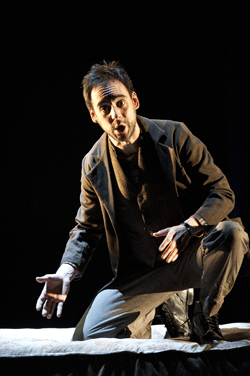 Pablo Bemsch
Pablo Bemsch
Massenet composed Le Portrait de Manon in 1894 as a one-act sequel to Manon. It is an excellent choice, coming after the Royal Opera House productions of Manon and Cendrillon. Knowing the background is valuable, as Le Portrait de Manon is essentially an epilogue to Manon. However, this Young Artists production was good enough that it could stand on its own.
Des Grieux (Zhengzhong Zhou) has grown old and bitter, so trapped in his grief that he's irritated when his lively young nephew Jean (Hanna Hipp) falls in love and wants to marry. The set (Sophie Mosberger) is very well designed, emphasizing Des Grieux's isolation, despite the trappings of wealth. There's a long rumination, in which Des Grieux sings about his past. Zhengzhong Zhou worked two years in France, and sang Valentin in Gounod's Faust earlier this month, so although he's only 27, he characterized Des Grieux's personality with emotional depth. His makeup was so well done, he looked as mature as he sounded. Pablo Bemsch, as Tiberge, Des Grieux's friend, was also very convincing, extending our sympathy with the predicament. Des Grieux isn't being unreasonable when he opposes Jean's marriage: perhaps he doesn't want the young man to be hurt as he was.
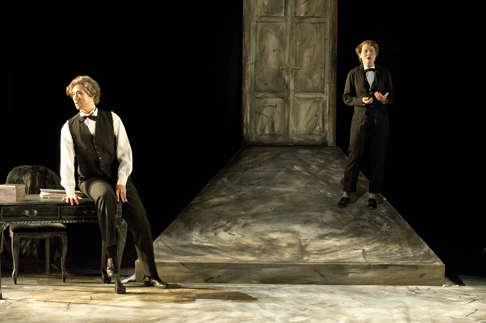 Zhengzhong Zhou as Des Grieux and Hannah Hipp as Jean
Zhengzhong Zhou as Des Grieux and Hannah Hipp as Jean
Love and youth will triumph, after all, as this is opera. Hanna Hipp is one of this year's new members of the Young Artists scheme, but she impressed greatly even as a student several years ago at the Guildhall School of Music and Drama. Here she's a vivacious young scamp in trousers. Maybe Des Grieux is right, Jean's too young to be tied down. But Hipp and Aurore (Susana Gaspar) are spirited, and their confidence in their roles makes the resolution inevitable. Stunned by Aurore's appearance, dressed as Manon, Des Grieux remembers and relents. If Manon the opera is tragic, Le Portrait de Manon is an invigorating romp, and in this performance, deftly executed.
Berlioz’s Les Nuits d'été is a song cycle, and even in the 1856 orchestral transcription heard here, doesn't transfer easily to the stage. In theory, there's no reason why not, and the undercurrent of dream unifies the group of songs. While the staging for Le Portrait de Manon was concise, enhancing, adding to meaning, the staging for Les Nuits d'été was clumsy. One bed might have sufficed. These songs express states of mind, not different characters.
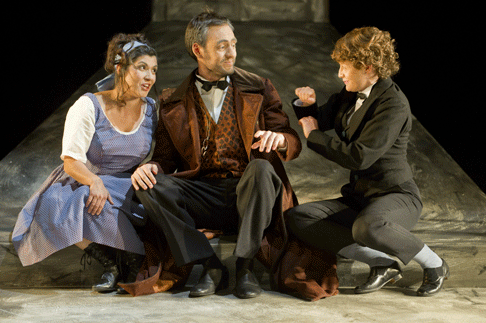 Hannah Hipp as Jean, Pablo Bemsch as Tiberge and Susana Gaspar as Aurore
Hannah Hipp as Jean, Pablo Bemsch as Tiberge and Susana Gaspar as Aurore
Pablo Bensch had been interesting as Tiberge earlier, so I was looking forward to his Villanelle. Unfortunately orchestra and singer weren't properly aligned, the winds entering insensitively, throwing the vocal line off kilter. Fortunately, Bemsch was better supported in Au Cimitiere. Hanna Hipp and Susana Gaspar sang the other songs. The balance was good, making a case for mixed voices. Berlioz sanctioned this, but it's usually impractical in recital — another good reason for paying attention to Young Artists Events, where repertoire is often approached in interesting ways.
Anne Ozorio
image=http://www.operatoday.com/JPYA_LES-NUITS-DETE-01.gif image_description=Hannah Hipp [Photo © The Royal Opera / Richard Hubert Smith] product=yes product_title=Jules Massenet: Le Portrait de Manon; Hector Berlioz: Les Nuits d’été product_by=Aurore: Susana Gaspar; Jean: Hanna Hipp; Tiberge: Pablo Bemsch; Des Grieux: Zhengzhong Zhou. Conductor: Geoffrey Paterson (Le Portrait de Manoin). Volker Krafft (Les Nuits d’été). South Bank Sinfonia. Director: Pedro Ribeiro. Designer: Sophie Mosberger. Lighting: Warren Letton. Movement: Mandy Demetriou. Royal Opera House Jette Parker Young Artists, Linbury Studio Theatre, 18th October 2011. product_id=Above: Hannah HippPhotos © The Royal Opera / Richard Hubert Smith
Don Giovanni in San Francisco
San Francisco Opera unveiled a new Don Giovanni just now in nearly direct competition with the new Giovanni from the Met (you can see it soon on Live in HD). Of course the Met has avoided an American take on this old story as well, preferring to impose still more British artistic imperialism on Americans.
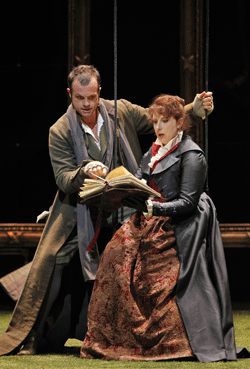 Marco Vinco as Leporello and Serena Farnocchia as Donna Elvira
Marco Vinco as Leporello and Serena Farnocchia as Donna Elvira
The SFO Giovanni is all about egoism, and we are not talking just about the libidinous Don. We are of course talking about SFO music director Nicola Luisotti. Like the Don, this maestro is much larger than life, and equally astonishing in his powers. But the Luisotti Don Giovanni is not about sex as it is for most stage directors, it is about how Luisotti can take you to the brink of lyric orgasm and hold you there longer than maybe you ever thought possible.
Of course the maestro did need some collaborators to support his lyric blowout, specifically a general director willing to suspend artistic judgement and engage a stage director who is at home on secondary Italian stages where standards are parochial to say the least. One Gabriele Lavia was Luisotti’s collaborator for his Salome in Bologna shortly after the San Francisco one (if in Bologna it was orchestrally more brilliant the staging was even cornier than in San Francisco).
The comedy of Mozart’s sublime tragicommedia in San Francisco was watching Sig. Lavia keep the maestro’s singers on a plain about 4 feet wide across the stage apron where no one could escape the maestro’s thrall. And still tell the story. It sometimes worked, sort of, belying the not-too-distant link of Mozartian dramaturgy to the linear and static placement of singers for Baroque opera seria.
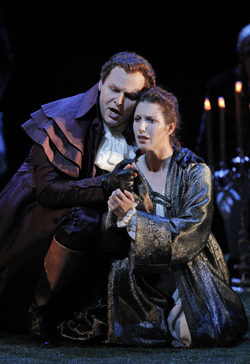 Shawn Mathey as Don Ottavio and Ellie Dehn as Donna Anna
Shawn Mathey as Don Ottavio and Ellie Dehn as Donna Anna
General Director Gockley as well engaged a small scale, very Italiate diva, the splendid Serena Farnocchia whose bright lyric voice is on the small side for Donna Elvira, and light enough to negotiate, almost, Elvira’s very difficult music at the speed of light. The maestro succeeded in upstaging Sig.ra Farnocchia’s “Mi tradi” with a hyper emotional orchestral accompaniment to its recit (grotesque heaving).
Donna Anna was the American soprano Ellie Dehn who had made little impression as the Figaro Countess last fall. But she glowed vocally as a retiring Donna Anna, her just ample enough voice blended perfectly in ensembles, having shown with hanging beauty and fine musicianship in her first act aria "Or sai chi l'onore.” American tenor Shawn Mathey was Don Ottavio, but not the usual impotent one. Turning the tables he was the singer with the coglioni rather than the usual Giovanni heroines. Both Don Ottavio arias were blockbusters, exposing forceful, detached tones in quick passages and fioratura, and letting tone and feeling explode in lyric passages. Both Ms. Dehn and Mr. Mathey managed a synergy with the maestro to sublime effect.
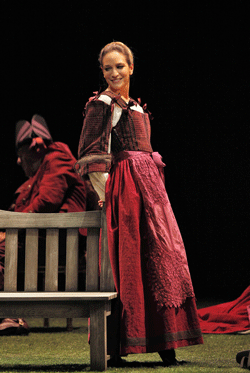 Kate Lindsey as Zerlina
Kate Lindsey as Zerlina
Ignoring all potential complexities of relationship to his master, Italian bass Marco Vinco made Leporello a cute, almost expendable character, needed but not wanted. Though he, like most all Leporellos earned the biggest ovation. Like Leporello, Zerlina and Masetto were needed only for the maestro’s beautifully wrought ensembles, but not much more. Zerlina was ably and musically sung by Kate Lindsey, Adler Fellow Ryan Kuster made a cute Masetto.
San Francisco regular, bass baritone Lucas Meachem filled the shoes of Don Giovanni with aplomb and even charm. Mozart did not endow his most loved character with arias of consequence, and a stage director must dig way beneath the surface to intuit any complexity of personality, obviously not the scope of this production. But the Don is always big, and he lets it all hang out in his explosion at the end of the first act. Needless to say this was the meat of the maestro who turned it into an absolute frenzy. Mr. Meachem could not possibly compete, though he gave it a good try. The real Don would have thrown this maestro the very graphic up-yours gesture and walked off the stage.
From the downbeat of the overture Mo. Luisotti stated that this Mozart opera was an orchestral and musical process, its very sound groaning with importance, reminding us that the maestro has made his orchestra into one of the world’s fine pit ensembles. The beginning foretold the absolutely literal ending with the Commendatore, ably delivered by bass Morris Robinson, wreaking his vengeance on the Don in gigantic symphonic terms. We discovered last fall that after the maestro’s over-the-top musical dénouement in The Marriage of Figaro that he could not touch the quiet Mozartian humanity that ends Figaro. And here he does not even look for Mozart’s humanity, ending Giovanni with the Don’s noisy descent into hell rather than letting the quietly splendid Prague sextet wipe up the mess.
It was a fun evening. However Mozart and San Francisco might equally enjoy a bit of operatic integrity.
Michael Milenski
image=http://www.operatoday.com/DG--Don.gif
image_description=Lucas Meacham as Don Giovanni [Photo by Cory Weaver courtesy of San Francisco Opera]
product=yes
product_title=W. A. Mozart: Don Giovanni
product_by=Donna Anna: Ellie Dehn; Donna Elvira: Serena Farnocchia; Leporello: Marco Vinco; Don Giovanni: Lucas Meacham; Don Ottavio: Shawn Mathey; Zerlina: Kate Lindsey; Masetto: Ryan Kuster; The Commendatore: Morris Robinson. War Memorial Opera House. San Francisco Opera Orchestra and Chorus. Conductor: Nicola Luisotti. Stage Director; Gabriele Lavia; Set Designer: Alessandro Camera; Costume Designer: Andrea Viotti; Lighting Designer: Christopher Maravich. (10/18/2011). Photos by Cory Weaver, courtesy of San Francisco Opera.
product_id=Above: Lucas Meacham as Don Giovanni
Photos by Cory Weaver courtesy of San Francisco Opera
October 24, 2011
Oedipe, La Monnaie, Brussels
By Francis Carlin [Financial Times, 24 October 2011]
Oratorio or opera? Enescu’s only work for the stage is such a fascinating score that the question seems of secondary importance. First performed at the Paris Opera in 1936 and very rarely heard since, Oedipe is Enescu’s musical testament, a richly harmonised compendium of tradition and modernity.
Der fliegende Holländer, Royal Opera
When this production of Wagner’s Der fliegende Holländer premiered at the Royal Opera House in February 2009, (review here), Bryn Terfel was its raison d’être. His absence was sorely felt, even by those who aren’t usually seduced by his charms. In this revival, the draw was Jeffrey Tate’s return to Covent Garden after nearly 20 years.
Minimal stagings can work when they highlight meaning and music. Tim Albery’s production (designed by Michael Levine) is a blank canvas, which styles The Flying Dutchman rather than suggests much about who he is. No portrait of any kind in sight. Instead, a toy boat. The boat itself is wonderfully staged, and it’s a masterstroke to see real water on stage, lit so its reflection shines magically into the auditorium. But it doesn’t convey the wildness of the open ocean, nor the turbulent psychic storm around which this opera predicates.
Perhaps Albery’s interpretation is that the opera predicates on Senta and her frustratons, the Dutchman being a projection of her fantasies. Anja Kempe’s Senta was extremely impressive in 2009. Then, she was a perfect foil to Terfel’s solid, taciturn Dutchman. Kempe’s energy created Senta as driven to extremes to escape what to her might have seemed mind numbing conformity. The Dutchman is her ticket out of town, rather than a cursed soul. It’s a valid interpretation, given Albery’s factory staging of the spinning scene, and marginal references to the haunted ship. The concept is worth exploring, though here it’s rather too simplistic. Senta’s not Tosca. Wildness is tricky to sing into this part, and occasionally Kempe relied more on forcefulness than finesse. Nonetheless, she can do it well, and should settle further into the run.
Egils Silins was a late replacement for Falk Struckmann as The Dutchman. This was his Covent Garden debut, and possibly his highest profile performance to date. Although his voice isn’t particularly distinctive, he’s secure vocally and does seem to have a feel for the part. In a production where the singer has more to work with and is less exposed, he’d make a bigger impact. Part of this stems from Albery’s approach, where the Dutchman is reduced to little more than Senta’s dreams. It takes an unusually powerful and charismatic singer to counterbalance these limitations.
Stephen Milling’s Daland was forcefully secure, even too noble, given that the character has an unpleasant streak of venality, which would work well in Albery’s concept, but wasn’t developed. Still, it’s enough that he sang well. Endrik Wottrich’s Erik had problems with pitch and intonation, but was reasonably well acted. Clare Shearer’s Mary was excellent — no fault of hers that the role here was a cipher.
The role of Steersman is much bigger, and critical to the plot, for the Steersman is guides the ship into the distance. Both Senta and the Steersman dream, but Senta can’t think past the present. John Tessier has to sing suspended up a rope ladder, but hasn’t quite the character to make the part as compelling as it might be. But then many productions don’t make enough of the role, and this production doesn’t, either. It’s odd, given Albery’s interest in images of conformity as the Steersman is part of the crew. As always, the Royal Opera House choruses sing and move perfectly. The vocal battle between the Dutchman’s crew and Daland’s crew isn’t quite as horrific as it might be, but the “Steuermann, laß die Wacht!” refrain was sung with such jaunty zest that it left no doubt that these sailors and their families had no time for spooks and neurosis.
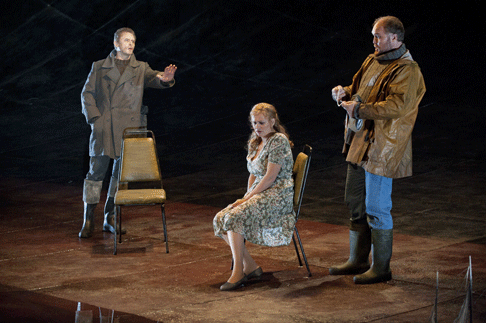 Egils Silins as Der Holländer, Anja Kampe as Senta and Stephen Milling as Daland
Egils Silins as Der Holländer, Anja Kampe as Senta and Stephen Milling as Daland
And so to Jeffrey Tate’s long awaited return to London. Fortunately Albery did not stage the protracted Overture, so we could concentrate on the orchestra. Tate’s pace was electric, injecting the malevolent atmosphere the staging tried so hard to suppress. The energy dissipated at other points, which was a kindness to the singers, who didn’t have to compete, and to Albery’s staging, which was so much at odds with the demonic, elemental fury in the music. When the Dutchman’s crew descend back into the bowels of their ship, Tate lets the orchestra burst forth again. They’re back on the ocean again, metaphorically defying storms and tribulations.
For more details, please see the Royal Opera House website.
Anne Ozorio
image=http://www.operatoday.com/Dutchman_ROH_03.gif image_description=Egils Silins as Der Holländer and Anja Kampe as Senta [Photo by Mike Hoban courtesy of The Royal Opera House] product=yes product_title=Richard Wagner: Der fliegende Holländer product_by=Daland: Stephen Milling; Steersman: John Tessier; The Dutchman: Egils Silins; Senat: Anja Kempe; Mary: Claire Shearer; Erik: Endrik Wottrich Orchestra and Chorus of the Royal Opera House. Chorus Director: Renato Balsadonna. Conductor: effrey Tate. Director: Tim Albery. Set designs: Michael Levine. Costumes: Constance Hoffman. Lighting: David Finn. Movement: Philippe Giradeau. Royal Opera House, London, 18th October 2011. product_id=Above: Egils Silins as Der Holländer and Anja Kampe as SentaPhotos by Mike Hoban courtesy of The Royal Opera House
October 23, 2011
Renata Pokupić, Wigmore Hall
Ranging far from the coloratura repertoire with which she has primarily made her name in the opera house, Pokupić was perhaps more comfortable with the impassioned folk sentiments of Dvořák’s Cigánské melodie (Gypsy Songs) and the flamboyance of Weill’s songs from Marie Galante than with the poised control of Schubert’s late lieder or the expressive nuances of Enescu’s settings of Clément Marot; but, supported by the typically accomplished accompaniments of Roger Vignoles, she presented an engaging sequence of song to a receptive audience.
The opening four Schubert songs, all composed during the last two or three years of the composer’s death in 1828, reveal the extraordinary diversity that Schubert achieved within the small form. Drawn and translated by Edward von Bauemfeld from Shakespeare’s The Two Gentlemen of Verona, ‘An Silvia’ is a sweet serenade to the eponymous protagonist. Adopting a tender, reflective tone Popukić revealed flashes of glimmering brightness, as the narrator remarked nature’s adoration of Silvia’s powers – “the wide fields praise her” and “Her gentle child-like charm refreshes”. Unfortunately, ‘Im Abendrot’ (‘Sunset glow’) and ‘Die Junge Nonne’ (‘The young nun’) were marred by some insecure intonation and melodic uncertainty; Popukić particularly struggled to control sustained pitches and confined melodic contours. Moreover, though the larger dramatic canvas of the final song suited the mezzo soprano’s temperament, a fittingly vigorous outburst as the nun rejoices in her transfiguring love for her God – “The loving bride awaits the bridegroom,/purified by testing fire -/ wedded to eternal love” – revealed plenty of power and fire, but also some unpleasant pushing of the voice at the expressive climax.
Roger Vignoles is a master of the judicious accompaniment, creating consistent, understated textures from which significant bass figures, telling melodic motifs and pointed expressive gestures sleekly arise to effortlessly assert themselves and then surreptitiously fade, always in expressive service of the text or diplomatically responding to the singer’s needs. This was most powerfully evident in the Schubert songs. Thus, the gentle ‘strumming’ of ‘An Silvia’ was momentarily enlivened by melodic echoes of, and dialogue with, the voice, all the while underpinned by the springing dotted rhythms of the leaping bass. And, appreciative of the way these ‘miniature’ forms can contain significant emotional depths and range, and alert to the overall structure and drama, he expertly controlled the rubato and brief but affective alternation of major and minor tonalities in the penultimate stanza of ‘Im Frühling’, restoring the settled ambience at the close. Sweeping, arpeggiated chords radiated the warm, golden gleam of the glowing sun in ‘Im Abendrot’, then gave way to the ‘raging storm’ – conveyed by an energised, oscillating bass, trembling beneath clanging treble cloister bells – in ‘Die junge Nonne’.
A more centred vocal line, amid adventurous harmonic progressions, was achieved in the ardent ‘Estrene à Anne’ (‘A gift for Anne’), which began the sequence of five songs from the Romanian George Enescu’s Sept Chanson de Clément Marot. Popukić effectively negotiated the rather archaic French texts and demonstrated much feeling for textual meaning and nuance, particularly in ‘Languir me fais’ (‘You make me pine’), where Vignoles’ elegant piano introduction adeptly established the reflective mood. She enjoyed the wit of ‘Aux damoyselles paresseuses d’escrit à leurs amys’ (‘To young ladies too lazy to write to their friends’), pianist and singer crafting an adroitly calculated, insouciant reading. Popukić’s delightfully rich lower register was much in evidence in ‘Changeons propos, c’est trop chanté d’amours’ (‘Let’s change the subject, enough of lauding love’), an unsentimental drinking song which galloped and then collapsed in a inebriated conclusion in praise of liquor and its celebrants, Bacchus and Silenus, who: “drank standing bolt upright;/ then he would dance,/ and bruise himself/ his nose was as red as a cherry;/ Many are those descended from his race.”
The second half of the recital found Popukić in her more natural element, whether embodying the bohemian personae of Dvořák’s folk songs, which tell of the joys and hardships of gypsy life, or enjoying the cabaret lilt of Weill’s songs for Jacques Déval’s play, Marie Galante. Popukić proved herself capable of shaping and controlling wide-ranging melodic arcs and leaping between registers, and of communicating extremes and contrasts of emotion, in the Cigánské melodie. An intense gravity characterised ‘My song resounds with love to me again’, as the narrator experiences both joy and loss, “when I am glad that, freed from misery/ my brother dies”; and deep melancholy underpinned ‘And the wood’s silent all around’, despite the warm major harmonies. Similarly, the arching melodic phrases of ‘Songs my mother taught me’, beautifully fashioned by Popukić with lustrous tone and enriched by the piano’s decorative ornamental motifs and propelling syncopations, presented a poignant blend of contradictory sentiments. A wilder more festive mood was created in the following two dances, ‘The strings are tuned, my lad’, and ‘Wide sleeves and loose trousers’, as Popukić at last fully relaxed, relishing the nonchalant fluctuations of pace and the unrestrained celebrations of freedom and music.
In Weill’s tango-inspired ‘Youkali’, Popukić unleashed a sultry low register and suave lyricism, saving a dulcet floating colour for the closing phrase as the narrator reflects that, whatever tedium we must endure in life, the human soul seeks escape, “oblivion everywhere”: “to find the mystery,/ where our dreams are buried/ in some Youkali.” The melodramatic grotesquery of ‘Le grand Lustucru’ (‘The Great Bogeyman’) and the extravagant dramatic sentiments of ‘J’attends un navire’ (‘I wait for a ship’) allowed Popukić to indulge her theatrical instincts, bringing the recital to an energetic and highly entertaining conclusion.
Claire Seymour
Programme:
Franz Schubert: ‘An Silvia’ D891; ‘Im Frühling’
D882; ‘Im Abendrot’ D799; ‘Die junge Nonne’ D828.
George Enescu: Songs from Sept chanson de Clément Marot Op.15
Antonín Dvořák: Cigánské melodie (Gypsy Songs) Op.55
Kurt Weill: Songs from Marie Galante
image=http://www.operatoday.com/Pokupic.png image_description=Renata Pokupić [Photo by Chris Gloag courtesy of Intermusica] product=yes product_title=Renata Pokupić, Wigmore Hall product_by=Mezzo-soprano: Renata Pokupić; Piano: Roger Vignoles. Wigmore Hall, London, Monday 17th October 2011. product_id=Above: Renata Pokupić [Photo by Chris Gloag courtesy of Intermusica]Intertwining facets of Italian High Baroque
Judith, Esther, Delilah, Bathsheba, Mary Magdalen, Saint Cecilia, Saint Agatha and their companions were the favorite heroines of those stories, inasmuch their feminine charms, and their dangerous influence on men’s behavior, were often graphically described in the librettos.
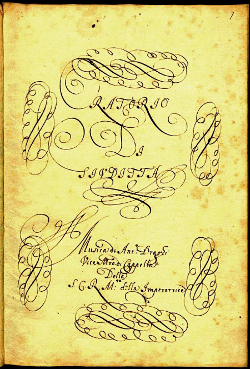 Manuscript title page of Oratorio di Giuditta © Oesterreichische Nationalbibliothek, Vienna
Manuscript title page of Oratorio di Giuditta © Oesterreichische Nationalbibliothek, Vienna
La vedova generosa [The Generous Widow] is the recently identified subtitle for Giuditta, one among the several dozens oratorios written by the Rimini-born composer Antonio Draghi (1634/35-1700) for the Habsburg imperial court at Vienna. One may scent therein a tribute to Draghi’s generous employer, the empress dowager Eleonora Gonzaga, whose musical household in Vienna was second only to that of her stepson, the music-avid (and amateur composer) emperor Leopold I. Both Eleonora and Leopold were devout Roman Catholics, much Italianate in their taste for music drama. Besides opera proper, they invested a good amount of their time and financial resources on oratorios, a musical entertainment originally devised by St. Philip Neri to keep people off the dangerous enticements of secular theaters, but soon transformed into a “perfect spiritual melodrama”, as abate Arcangelo Spagna, a theorist, put it in 1706.
Thus the subject of Judith, the ‘generous’ Jewish widow who delivered her people from the Assyrian chieftain Holofernes by means of unorthodox sexual warfare, could not escape Eleonora’s attention, nor the one of an ambitious court composer. Just months after the premiere performance, which arguably took place some time between Lent 1668 and Lent 1669, Draghi was promoted from the Empress’ to the Emperor’s service, with a substantial raise in his salary.
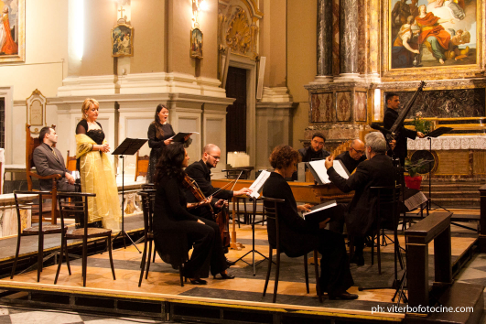 Rimini, Ensemble Seicentonovecento in Draghi’s Giuditta [Photo by Fabiana Rossi]
Rimini, Ensemble Seicentonovecento in Draghi’s Giuditta [Photo by Fabiana Rossi]
So much for the historic background. As to the music itself, Draghi’s Giuditta stands mid-way between the earlier, Cavalli-style, Venetian opera and the progressive Neapolitan school launched by Alessandro Scarlatti during the following decade. The prevailing syllabic recitative is largely peppered with elaborate florid passages, and most cadenzas soar to eloquent ariosos in triple time, sometimes with a dance-like lilt. Although just two numbers are formally labeled “aria” in the manuscript score, there are actually a few more. While only the final ensemble for the four soloists (Judith, her maid Abra, Holofernes and the Narrator) brings the caption “da capo”, two arias for Abra - somewhat of a comic character - are clearly set in the the ‘modern’ ternary form A-B-A`, a daring experiment for the times. However, the centerpiece is a long and articulate conversation scene between Holofernes and Judith, totalling nearly one fourth of the entire work. It’s a red-hot skirmish between the lusty chieftain and his would-be victim; the former voicing his desire enhanced by heavy drunkennes, the latter pretending to reciprocate but determined to cut his head as soon as he falls asleep.
Every manner of compositional devices are employed here, from secco recitative, through arioso, to outright aria (particularly compelling is “In dolce calma” for Holofernes, accompanied by a pair of gambas). Minutes before accomplishing her brave deed, Judith fulfills the dearest expectation of any early opera-goer: a lament on a descending chromatic tetrachord, the time-honored emblem for grief and supplication (“Pietà Signor”).
Such a precious rediscovery was presented in Draghi’s native city as a special project within the 62.nd installment of the Sagra Musicale Malatestiana, a major festival series attracting visitors from several countries. For the third year in a row, Italian and Austrian institutions joined forces to celebrate Draghi, hitherto an injustly neglected composer of the Baroque era. Contrary to the current fade for oratorios, the Rome-based Ensemble Seicentonovecento led by Flavio Colusso didn’t arrange a fully staged production. The venue, a large 18th-century Jesuit church in downtown Rimini, offered visual attractions enough. No props, very few movements from the singers, and passages from period sermons delivered by actress Silvia De Palma shaped the performance as close as possible to the original conditions: half private entertainment, albeit in fashionable court circles, and half act of religious worship. Of course, most credit for the success goes to the music department. A scanty yet energetic ensemble of two violins, theorbo, organ and harpsichord accompanied a quartet of vocal soloists conversant both with the dramatic subtleties of recitar cantando and the virtuosic coloratura of late 17th-century bel canto. Two recognized specialists as sopranos Gemma Bertagnolli (Giuditta) and Elena Cecchi Fedi (Abra) were complemented by the up-and-coming bass Luigi De Donato (Oloferne) and by the male alto Antonio Giovannini, a beginner who seems poised for great things.
Robert Wilson’s fans use to maintain that he deepens and actualizes the dramaturgy of those operas he happens to stage. In my opinion, either is hardly true, as the Texan director’s strategy apparently aims at sucking the life out of any particular opera, freezing down its dramaturgy deep below the zero point in the pursue of such ritual impassiveness as it was probably the case with the original Greek tragedy - and still is with the Byzantine church liturgy, the Japanese Nô, India’s Katakhali or Stockhausen’s Licht cycle. To be sure, all these theatrical or quasi-theatrical genres are indented in a respectable religious vision where issues of style, symbols and formality are paramount, but actualization is obviously ruled out, while deepths of emotion (if any) are the individual elaboration of their devout attenders. Whether about Parsifal or Aida, Gluck’s French Orphée or his Monteverdi forerunner Orfeo, each of Wilson’s productions closely resembles but Wilson, just as any Mass resembles another Mass, leaving aside such local details as the language of the sung texts and the music accompanying them.
The present Ritorno di Ulisse - being the middle panel of a Monteverdi/Wilson trilogy scheduled by La Scala in co-production with the Paris Opéra between 2009 and 2013 - sticks to the trend: neither reconstruction nor deconstruction of the Classic, rather an embalming of it as in a classy funeral parlour. In the Prologue, the curtain rises on a backdrop mirroring Poussin’s Le Printemps, an Arcadian landscape inhabited by cute Disney-esque animals and mimes embodying Love, Fortune, Time and Human Frailty; too bad that the corresponding singers are plunged in the pit to the disadvantage of audibility. The core action revolves within hollow spaces ‘representing’ the sea or the Olympus, while the royal palace at Ithaca, where Penelope is detained in self-imprisonment, is aptly surrounded with menacing black slates.
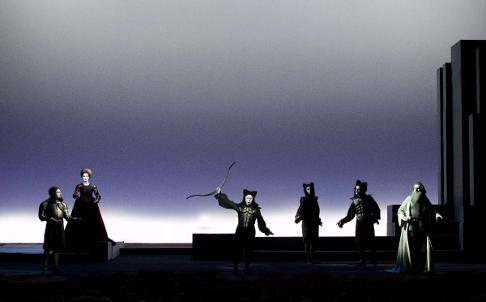 The Bow Contest scene [Photo by Lucie Jansch]
The Bow Contest scene [Photo by Lucie Jansch]
Deities and human beings, the powerful and the destitutes, the goodies and the villains, look equally unimpassioned and hieratic; static figures striking enigmatic poses with their white-gloved hands and their pale, heavily made-up, faces. Most of them, enclosed in Baroque parade armours, are donning lofty wigs or feathered bonnets. A déjà vu from the court pageants at Paris and Vienna during the mid 1600s, thus leaving the timeline near the 1640 premiere of the opera. What else? Colour-coded lighting schemes and sparse but effective props: Ulysse’s bow, the skeleton of a ship bottom, a Greek idol on a column.
Deaf to the minimal-chic mermaids of Wilson’s staging, Rinaldo Alessandrini offered a vibrant rendering of the score, despite the many uncertainties surrounding the actual completness of the unique Vienna manuscript (the critical edition he lately prepared for Bärenreiter underwent a few cuts as well as some educated guesses about the instrumental colours). The continuo players of his Concerto Italiano added authentic flare to a selection of strings from the Scala pit orchestra. Thus Monteverdi’s explicit concern for "affetti" (human passions) revived from Wilson's ritual fridge, also thanks to a company of all-Italian voices where Sara Mingardo and Furio Zanasi, both accomplished artists beyond strict specialist boundaries, towered as Penelope and Ulisse. Luca Dordolo made a graceful Eumete, Marianna Pizzolato a convincing Ericlea, Leonardo Cortellazzi’s Telemaco soared as the performance progressed. Among the double-bill cameos, basses Salvo Vitale and Luigi De Donato displayed remarkable panache. I only wonder what happened to brave Monica Bacelli, who for one time left aside her favorite breeches roles. Her Melanto, although allowed to display more acting liveliness than any other character in the show, betrayed an alarming vocal disarray. Hopefully just an off night.
Carlo Vitali
Cast Lists
Antonio Draghi: Oratorio di Giuditta (1668, libretto by anonymous)
Giuditta: Gemma Bertagnolli; Abra: Elena Cecchi Fedi; Testo [The Narrator]: Antonio Giovannini; Oloferne: Luigi De Donato. Ensemble Seicentonovecento (on period instruments). Flavio Colusso, conductor. Chiesa del Suffragio, Rimini, Italy. Performance of 20 September 2011.
Claudio Monteverdi: Il ritorno di Ulisse in patria (1640, libretto by Giacomo Badoaro)
Ulisse: Furio Zanasi; Penelope: Sara Mingardo; Eumete: Luca Dordolo; Telemaco: Leonardo Cortellazzi; Fortuna/Melanto: Monica Bacelli; Il Tempo/Nettuno: Luigi De Donato; a.o. Orchestra del Teatro alla Scala, with continuo elements from Concerto Italiano. Robert Wilson, director. Rinaldo Alessandrini, conductor. Teatro alla Scala, Milan, Italy. Performance of 28 September 2011.
image=http://www.operatoday.com/Penelope.png image_description=Sara Mingardo as Penelope [Photo by Lucie Jansch ] product=yes product_title=Antonio Draghi: Oratorio di GiudittaClaudio Monteverdi: Il ritorno di Ulisse in patria product_by=See body of review for cast lists product_id=Above: Sara Mingardo as Penelope [Photo by Lucie Jansch ]
October 20, 2011
Opera North's Queen of Spades - in pictures
[Guardian, 20 October 2011]
Neil Bartlett's new production of Tchaikovsky's great opera of gambling, of secrets, of love and death opens at Opera North on 20 October. We asked Bartlett - making his operatic debut - to pick his key moments from the production and tell us about them
October 12, 2011
Britten’s War Requiem, London
The final words of Benjamin Britten’s War Requiem are words of peace and hope, but recent and on-going conflicts in Rwanda, Liberia, Iraq, Afghanistan and Libya suggest that although almost fifty years have passed since the work was first performed, to celebrate the rebuilding and re-consecration in May 1962 of the bomb-blasted Coventry Cathedral, the sentiments of Wilfred Owen, voiced in the epigraph, have lost none of their impact or relevance: “My subject is War, and the pity of War. The Poetry is in the pity. All a poet can do today is warn.”
Much of the power of the work lies in its innate contrasts. Owen’s dark, distressing war poems form a counterpoint to the consolations of the requiem mass, and the interweaving of secular and sacred, vernacular and Vulgate, is often challenging, surprising and deeply ironic. A resonant, full orchestral clamour contrasts with delicate, finely fashioned chamber sonorities; soloists and chorus intertwine and counterpoise. Brightness interrupts the darkness, and is then once more overwhelmed by horror and terror.
Conductor Gianandrea Noseda, deputising for the indisposed Sir Colin Davis, was ever alert to such contrasts. Thus, in the opening ‘Requiem aeternam’, the lustre of high trebles of Eltham College Choir – placed distantly, as Britten requested, in the gallery – thrillingly broke through the solemn, funereal tolling of the orchestral accompaniment; similarly, the gentle phrasing of the women’s voices in the choral ‘Recordare’ was abruptly and dramatically superseded by the energetic, bellicose assertions of the men’s ‘Confutatis maledictis’. Elsewhere, the very quietness was itself imbued with ominous, discomforting resonances: the whispered conclusion to the fugal ‘Quam olim Abrahae’, following the terror of the lines, ‘the old man would not so, but slew his son, – And half the seed of Europe one by one’, was spine-chilling. Throughout the London Symphony Chorus were on fine form, enunciating the text clearly and attentive to all the significance musical details.
A cast of impressive soloists had been assembled. Ian Bostridge may have more than fifty performances of the War Requiem behind him but he is clearly not about to let any element of routine enter into his interpretation. In a recent interview he asked, “Which war, whose Requiem?” and his intense engagement with this question underpinned a remarkably committed performance, one which judiciously conveyed every nuance and inflection of the text. Never afraid to use the grain and catches of the voice to highlight the bitterness and ugliness expressed by Owen, Bostridge is totally attuned to the musical and poetic expression, uniting the power of both in his delivery. He produced a disturbing vehemence in ‘What passing bells for these who die as cattle?’ but created an exquisite, poised stillness in the ‘Agnus Dei’.
Baritone Simon Keenlyside was less overtly dramatic but he provided an effective base or grounding for the more extrovert tenor. Singing with sincerity and considerable beauty of tone, Keenlyside communicated authoritatively, especially in ‘Be slowly lifted up, thou long back arm’. In their duet passages, as the men sing with ironic cheerfulness of death, or chillingly relate the story of Abraham and Isaac, both singers displayed an admirable feeling for the text. Every word pulsed with meaning and import, especially in the final extract from Owen’s ‘Strange Meeting’.
The solo soprano is separated from the two male soloists, musically and textually, and here Slovenian Sabina Cvilak was spatially distanced too, placed in the choir. Singing the Latin text, ‘Liber scriptus’, which sets out day of judgement, Cvilak was perhaps a little too placid, not making full use of her undoubted rich tone, although the declamatory phrases of the ‘Sanctus’ were well-shaped and she displayed a pure tone and a well-supported pianissimo.
The players of the London Symphony Orchestra were on tremendous form, guided skilfully by Noseda who illuminated all the details of the score. Noseda’s control of the musico-dramatic form was exemplary and his galvanising of his forces in the big moments superb: thus the chilling distant fanfares which herald the outbreak of violent combat at the start of the ‘Dies Irae’ built to an explosive force. The full fury of the orchestral forces were sparingly employed and the turbulent outbursts perfectly judged, as in the frighteningly precipitous ‘Libera me’ in which the stifled percussion eventually detonated in a terrifying climax with the entry of the organ. In contrast, Noseda paced the more grave moments with controlled deliberation. The chamber ensemble which virtuosically accompanies the songs sensitively supported the intimate drama and dialogue of Owen’s verses.
In a recent essay in the Guardian newspaper, Bostridge wrote that, “The War Requiem is a masterpiece of the deepest emotional and moral depth. It is also an enormous contraption of musical ingenuity”. This was a purposeful and impressively crafted performance, one which powerfully expounded the human truths and elemental emotions exposed by Britten and by Owen; time does not lessen their importance or impact.
Claire Seymour
image=http://www.operatoday.com/Wilfred_Owen_2.gif image_description=Wilfred Owen product=yes product_title=Benjamin Britten: War Requiem product_by=Sabina Cvilak, soprano; Ian Bostridge, tenor; Simon Keenlyside, bass. Conductor: Gianandrea Noseda. London Symphony Orchestra. London Symphony Chorus. Eltham College Choir Trebles. Barbican Hall, London, 9th October 2011. product_id=Above: Wilfred OwenThreepenny Opera, Brooklyn
Should I wait before citing the superb performers with their rictus-expressions and balletic, Dr. Caligari-meets-Charlie Chaplin slapstick, the exquisite stage pictures and the orchestrated horselaughs, burps and farts that emerged from the orchestra, the tidily synchronized sound effects of a cane whipping through the air or a curtain pulled on its links, the nasty ancient jokes that seemed to hit targets as new as this morning on Wall Street right in the gold? For me, no lover of Wilson’s glacial opera stagings (Lohengrin, Einstein on the Beach), Threepenny went by as swiftly as a smutty shaggy dog joke with many a guffaw before the punchline, and I’d gladly see it again. No; I think I’ll start with my interpretation of the piece and its place in “operatic” history. Reviews of the performers will be the punchline.
The Beggar’s Opera, the Gay-Pepusch satire on opera seria as practiced (most notably by Handel) in London in 1728, tickled many a funnybone of its time with the princes and sultans and enchantresses of opera transformed into pimps, thieves, con-men and ladies of dubious repute. The dialogue was underworld slang and the tunes were pop songs of the day. Handel’s operatic reputation took ages to recover, and the threat of satire was always a-lurk in London thereafter for any artist taken too seriously. But the audiences who laughed were not the beggars or street people John Gay depicted on stage: They were the same middle and upper classes who had admired the no longer chic Handel.
Precisely two centuries later, in 1928 in Weimar Berlin, that hotbed of cynicism, social criticism and moral decay, Beggar’s Opera was reborn. Kurt Weill, a trained symphonist with an interest in jazz, and the Leftist playwright Bertolt Brecht transformed the London beggars into the dregs of Dreigroschenoper, satirizing the self-devouring of capitalist excess in a fable that epitomized their time and place. It also made a star of Weill’s lover, Lotte Lenya. An appropriately gritty film from 1931 survives, and a couple of the songs (“Mack the Knife,” “Pirate Jenny”) are standards. The only artistic interpretation of the Weimar era that is better known, at least in this country, is Kander and Ebb’s Cabaret, whose songs and personalities are prettified versions of the ones that shocked (and delighted) Berlin. Not coincidentally, the original Cabaret also starred Lenya.
Lenya’s participation in the “opera” is significant. Her voice may have been trained, but she was by no stretch of the imagination an opera singer. That was more than okay for the parts she sang; they are hardly bel canto roles. And throughout the Robert Wilson production, recently given at the Brooklyn Academy of Music opera house, I found myself wondering if the Brecht-Weill piece is an opera at all (most of it is spoken dialogue), and marveling at how the cast, none of them singing in an operatic manner, used their voices, cracked, exaggerated, twisted, sneering, insinuating, whining, caricatures in both dialogue and song, to express the antisocial, anti-sentimental story they had to tell. Threepenny Opera may be an anti-opera, but it is certainly music drama and vocal theater, thrilling, mythic, in your face.
No small part of the shock and the humor of the original Beggars’ Opera was provided by the contrast of its characters and their motivations—as well as their manner of singing—with the highfalutin pleasures of Handelian opera. Trained voices and their exquisite display were hardly the point of the songs of vengeance and sex and the lust for gold. The outrageous conclusion, with Macheath obliged (because it’s an opera) to live happily ever after with two girls who hate each other in order to suit the Handelian lieto final, undermined the aristocratic operatic morals. It was a dose of naturalism (then an unknown bird on the stage) to cure if not hack to death the artifice of the reigning form. Hacking actual reigning monarchs came a bit later.
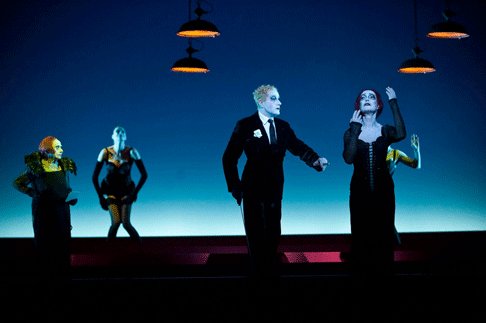 Ruth Glöss as the Old Prostitute, Stefan Kurt as Macheath and Angela Winkler as Jenny
Ruth Glöss as the Old Prostitute, Stefan Kurt as Macheath and Angela Winkler as Jenny
Over the centuries, each new theatrical step towards the “natural” has made the artificial seem more formal, more distant (Handel and his contemporaries were no longer performed) until a new sort of naturalism reigned. On the spoken stage, Scribe abandoned the royal court for the bourgeois drawing room, then Ibsen and Chekhov began to talk of things unfit for the drawing room ideal. To sum up this acceptable standard of “naturalism,” Brecht and Weill (and not only they) invaded the lowest reaches of society, with music of a studied grossness. Once naturalism has reached this extreme (and movies had created another revolution), their chic and their ability to shock soon vanished as well. Even before the triumph of the modern style of Regie-theater, Dreigroschenoper and its Brecht-Weill successors (Happy End, Mahagonny, Seven Deadly Sins) helped to invent a new theater that could only be absorbed and defused by presentation in a new artificial style. This was the occasion of Richard Foreman’s vividly formal production of Threepenny Opera with Raul Julia at the Beaumont Theater (a hit), of the John Dexter version on Broadway with Sting and Maureen McGovern (a flop), and—now—of the Robert Wilson interpretation come to New York.
Wilson, like Foreman, has his own style of artifice, imposed to some extent on every work he encounters: Philip Glass’s Einstein on the Beach, Wagner’s Lohengrin and Parsifal, Debussy’s Pelléas et Mélisande, the Stein-Thomson Four Saints in Three Acts. His encounters with the slow movement and slowly gathering message of Wagner’s dramas might have seemed a perfect fit on paper; in practice, even with performers like Ben Heppner and Karita Mattila, there was a steady seepage of dramatic excitement. At the New York premiere of Einstein, more of the audience was outside the theater, talking about the production (scathingly or otherwise), than remained inside, enduring it.
In contrast, Weill and Brecht have a very swift-moving theater, a theater that holds our attention with much activity, roundabout schemes and betrayals, slowing down barely at all for sarcastic songful commentary and reflection on the action. This, set against typically Wilsonian bars of light (for the shelves in Peachum’s pawnshop or the rafters in Macheath’s garret or the bars on his prison cell) and enacted with a set of formalized emaciated staggers, sexy swivels, dancing wobbles and leaning crowds, has us riveted, paying determined attention to the stories being enacted. The acting is anything but natural, is cartoonish and expressionistic at once, to the extent that the most vulgar gestures are as polite as silhouettes, the most monstrous jokes evoke giggles. These people are not real, and for once none of them attempt to be. Lucy Brown reacts to Mack’s betrayal with a face like Munch’s The Scream. Celia Peachum rolls her considerable bulk about in a parody of both aging sexuality and desperate petit-bourgeois propriety. Mack himself never changes his grin, whether he is seducing, betraying, murdering or being betrayed. The skull-like Tiger Brown indicates only with a voiced jowlishness his regret at stiffing his old friend. Jenny seems too battered by years as a whore to have any emotion left whether selling her lover to his enemies or rescuing him. It’s a puppet show, a carnival Faust for open-mouthed children, and when real issues like corporate wealth and its exploitation of poverty come up—as the subjects did, to much delighted laughter during performances while the Occupy Wall Street movement camped out not two miles to the west of BAM—it is perhaps to show us how close our lives have become to caricature, to send up the whole notion of a “naturalistic” theater that dares to ignore our current crisis.
In the large and excellent cast, all choreographed to suit a set of invisible furnishings and doors, Traute Hoess, the drunk and Machiavellian Mrs. Peachum, was perhaps the standout. She had, after all, more to do, more to connive, more to betray. Her hypocrisy was so very enthusiastic. Stefan Kurt performed Macheath with joy in his own villainy and egoism. Axel Werner was Tiger Brown, the skeletal old comrade, a chief of police whose lot of betrayals is not a happy one. Stefanie Stappenbeck, as Polly, symbolically renounced her illusions by changing her expression on finding another woman in her new husband’s bed—but if she can sing “Pirate Jenny,” how deluded can she be? Angela Winkler managed to look and sing as if she had lived in a garret with a pimp for forty years. Betraying him and cuddling him by turns draws no reaction from her, no alteration of the set line of her mouth and stringy hair: a dead soul. The balletic crooks in Mack’s band deserve credit for their spooky chorus line.
I have to admit a genuine regret that the happy ending was retained—the evening seemed to cry out for a hanging. But whom would you hang? Macheath the thieving, murdering bigamous pimp, or his society and its more subtle criminals? At least these guys could make us laugh. None of the fat cats they aped and mocked are capable of that.
John Yohalem
image=http://www.operatoday.com/THREEPENNY_11_PC_STEPHANIE-.gif image_description=Stefanie Stappenbeck as Polly and Stefan Kurt as Macheath [Photo by Stephanie Berger courtesy of Brooklyn Academy of Music] product=yes product_title=Kurt Weill: Dreigroschenoper (Threepenny Opera) product_by=Macheath: Stefan Kurt; Peachum: Jürgen Holtz; Mrs. Peachum: Traute Hoess; Polly: Stefanie Stappenbeck; Tiger Brown: Axel Werner; Jenny: Angela Winkler; Lucy: Anna Graenzer; Filch: Georgios Tsivanoglou. Production, direction, light concept by Robert Wilson. The Threepenny Orchestra. At Brooklyn Academy of Music, performance of October 7. product_id=Above: Stefanie Stappenbeck as Polly and Stefan Kurt as MacheathAll photos by Stephanie Berger courtesy of Brooklyn Academy of Music
Simon Rattle’s Mahler 9
Some interpretations of Mahler’s Ninth Symphony benefit from live recordings, and Rattle’s is one of them, with tempos and textures that convey the score as vividly as Mahler composed it. The details of the score are important, as evident in the fair copy of the work, which was not yet performed when Mahler died. Those who have had the privilege of examining that manuscript, though, are aware of the revisions that it contains as the composer annotated it thoroughly. In contrast to the earlier draft score, which contains some personal exclamations, about youth, love and farewell, the fair copy lacks such indications. Instead, it contains details of scoring, articulation, expression, and phrasing that convey instead the vitality of the music, which emerges with appropriate style in this recent recording of the work.
As much as many have special feelings about the “Finale” of the Ninth, the first movement stands out a seminal work that bridges the Romantic world and twentieth-century music. In this recording Rattle offers a thoughtful reading of the first movement, which lasts almost twenty-nine minutes. It is a spaciously planned performance that unfolds convincingly, with the musical logic behind the score evident in its execution, with the brief motifs found at the beginning of the movement clearly defined so that the musical narrative proceeds logical from the opening as the larger themes of the exposition take shape. The details of accompanying figures, including fanfares, glissandi, and other elements support the thematic content of the piece likewise have their place, as the contrast between smaller musical ideas and the larger structure becomes a dynamic feature of Rattle’s interpretation. More importantly, the sense of line, of musical continuity, is always apparent in this performance.
A similar masterful interpretation guides the performance of the two inner movements, with the second benefitting from the fine playing of the Berlin Philharmonic as it renders the details of the score with nuance and delicacy. The various orchestral colors remain as distinct in the performance as they occur in Mahler’s score. Tempos are likewise fluid, as Rattle brings the score to life as convincingly here was in the first movement. The sometimes angular lines in the low brass are characterized well, without the result ever seeming grotesque or otherwise departing from the fine sense of style that emerges from this performance.
The brass section brings this kind of finesse to the third movement, which has a sense of urgency that guides the ideas as they unfold. Here the woodwinds demonstrate their fine timbre and sense of ensemble in the textures Mahler scored carefully in this music. As clear as the details appear in this performance, they serve the line, which supports Rattle’s keen sense of the musical narrative in a virtuosic performance of the “Rondo-Burleske.”
Yet it is the “Finale” that many listeners recall strongly, and here Rattle offers a reading that supports the score without lapsing into heart-on-the-sleeve sentimentality. In following the details of Mahler’s score, Rattle serves the sense of music well, as it rich textures and full sonorities of the work are rendered vividly. The tone is entirely appropriate to the tempos, as it is possible to hear the articulation of chords and pitches resonate well throughout the movement. This interpretation is consistent with the elegiac sense that emerges in Rattle’s performances of “Der Abschied” in Das Lied von der Erde, a sense that is all the more admirable for the lack of verbal text in the Ninth to serve as a guide. The contrasts of texture and dynamics support the music line, which is clearly presented here as in the other three movements of this exemplary performance of Mahler’s Symphony no. 9. The conclusion complements the first movement, with the dynamic tension sustained through the final pitches, as they dissolve into silence at the end of this remarkable recording.
This is Rattle’s second recording of Mahler’s Ninth, with the other released separately and later reissued as part of the set of the composer’s symphonies by the conductor. As strong as the earlier recording may be, the second merits attention for subtle differences that it contains. The exceptional playing of the Berlin Philharmonic allows Rattle to create an outstanding recording of this masterpiece.
James L. Zychowicz
image=http://www.operatoday.com/Mahler9_Rattle.gif image_description=EMI Classics 5-01228-2 product=yes product_title=Gustav Mahler: Symphony no. 9. product_by=Berlin Philharmonic, Sir Simon Rattle, conductor. product_id=EMI Classics 5-01228-2 [2CDs] price=$15.99 product_url=http://www.arkivmusic.com/classical/album.jsp?album_id=188900Sallinen’s The Red Line at Finnish National Opera, 2008
Wozzeck is widely admired, but the typical American opera company will program La Boheme every few seasons, and maybe once a decade stage Berg’s masterpiece.
Aulis Sallinen’s The Red Line prompts much admiration as well. Premiered in 1978, the work combines both serious subject matter and a score that expertly walks that fine line between hard-core modernism and more “accessible” material. It’s easy to see why the Finnish National Opera would stage a major revival in 2008 — not least because the source material (a novel of the same name by Ilmari Kanto) centers on a major episode from Finnish national history.
Topi is a peasant, in all senses of the word — a man at the lower socio-economic end, striving to provide for his family, with a fierce will but earthy weaknesses. He and his wife Rikka have three children, and in tough economic times, they are finding it hard to keep them properly fed. Soon word comes that the vote is coming, and not only for men — but also for women. Political agitators tout this development as the key to improving living conditions for men like Topi and their families. The vote is to be cast by marking a “red line” on a ballot. But Topi can’t wait for a vote — one child is ailing. He goes to the Church for help, but any assistance is too little, too late, and the child dies. At opera’s end, the side supposedly representing Topi’s interests has indeed won a major election, but it matters little to Topi. A bear that had threatened his livelihood at the beginning of the opera reappears, and Topi rashly rushes to chase it off — only to end up its victim, a “red line” drawn across his throat. And his widow is left to care for the remaining children.
The libretto manages to be a social and political tract without feeling heavy-handed, at least as staged by director Pekka Milonoff. Eeva Ijäs’s simple, effective sets and the naturalistic costumes of Erika Turunen provide a sense of time and place, and an expert cast performs with affecting simplicity and commitment. A hard-core Marxist would be displeased that Topi is not elevated to heroic stature, and a hard-core reactionary would bemoan the critical depictions of the Church and the established ruling class. Sympathy is aroused for its forlorn protagonist, but we can also see where his own choices have contributed to his predicament.
Despite many powerful moments, the narrative doesn’t build, and the bear sections are too crudely symbolic. Although not a long opera, the first act drags, and a more compact structure might have had greater impact.
Sallinen’s score has many remarkable passages, weaving folk material, marches, and arias into a complex fabric. Conductor Mikko Franck and the Finnish National Opera Orchestra keep the tension high, but the handsome hall must have fine acoustics, as the singers are never swamped.
Sallinen couldn’t hope for a better Topi than that of Jorma Hyannin — the hang-dog expression on his handsome face capturing a lifetime of deprivation and struggle, but the fire in his eyes is unquenched (until the end). Päiva Nisula is his wife, larger than one might expect in a story about poverty, but that actually corresponds to reality, in many cases. She is just this side of caricature — hearty and strong, loving of her husband but prone to nagging. In a large supporting cast, Aki Alamikkotervo’s Agitator stands out for capturing the tunnel-visioned fervor of a politically driven man.
Ondine provides four separate filmed interviews as bonus features — with the composer, director, conductor, and star. Technically austere, the interviews don’t cover much interesting territory, with the exception of that with composer Sallinen. He is mordant and perceptive, and your reviewer will probably never forget one choice phrase of his, a reference to “man’s bottomless narcissism.”
The Red Line, some three decades on, does not look poised to join the standard opera repertory, but Sallinen is most fortunate to have this document for posterity, a recording of a fine performance of his admirable — if not exactly loveable — opera.
Chris Mullins
image=http://www.operatoday.com/Ondine_ODV4008.gif image_description=Ondine ODV4008 product=yes product_title=Aulis Sallinen: The Red Line product_by=Topi: Jorma Hynninen; Riika: Päivi Nisula; Sake: Tuomo Nisula; Raakeli: Sanni Vilmi; Iita-Linta Maria: Olivia Ainali; Puntarpää: Aki Alamikkotervo; Simana Arhippaini: Hannu Forsberg; Vicar: Pertti Mäkelä; Young Priest: Tuomas Tuloisela; Kaisa: Anna-Lisa Jakobsson; Raappana: Taisto Reimaluoto; Kunilla: Rea Mauranen; Epra: Ari Grönthal; Jussi: Marko Puustinen; Tiina: Leena Liimatainen; Constable Pirhonen: Kai Valtonen; Fate: Jarmo Rastas. Tsuumi Dance Company. Finnish National Opera Chorus and Orchestra. Mikko Franck, conductor. Pekka Milonoff, stage director. Eeva Ijäs, set design. Erika Turunen, costume design. Juha Westman, lighting design. Ari Numminen, choreographer. Recorded live from the Finnish National Opera, 2009. product_id=Ondine ODV4008 [DVD] price=$26.99 product_url=http://www.arkivmusic.com/classical/Drilldown?name_id1=10591&name_role1=1&bcorder=1&comp_id=375701La Traviata and the Credit Crunch
The opera deliberately suppresses references to the insubstantial nature of Violetta’s wealth. In La Dame aux Camélias (1848) by Alexandre Dumas fils, the novel on which the opera is ultimately based, there is a striking emphasis on the economy of courtesanship (aka prostitution). But when Dumas himself adapted his novel as a play he removed much of the unsentimental emphasis on the economic aspects of his heroine’s life, and when Francesco Maria Piave further adapted the play as a libretto for Verdi he removed most of what remained. At the heart of La Traviata there is a financial crisis as Violetta attempts to trade in the trappings of wealth for actual cash, but it is touched on as lightly as possible, and really serves simply as a catalyst for the moral crisis that Piave and Verdi wanted to explore.
The omitted material is strikingly relevant to recent headlines. Dumas emphasises that his heroine, Marguerite Gautier (Verdi’s Violetta), lives, and lives boldly and brilliantly, on credit. Her apparent “wealth” is counterfeit, and after her death her things are sold off to pay her creditors. Marguerite’s professional success turns a great deal on her willingness to run up large debts to fund a lavish lifestyle that will generate higher levels of income — this willingness to be highly indebted separates her from the rank and file courtesans. Both novel and play make it very clear that Marguerite is indebted when she starts her relationship with Armand (Verdi’s Alfredo), and that her decision to live with him downgrades her credit rating, forcing her to contemplate one act of downsizing after another. The opera, by contrast, allows the possibility that Violetta is genuinely wealthy at the beginning, and that she impoverishes herself simply by supporting Alfredo. All for love. A long tradition of presenting the first act very sumptuously tends to reinforce this impression: Violetta’s pre-Alfredo life appears to be all fine clothes, fine wines and expensive frivolity.
Dumas’s Marguerite is financially irresponsible, but in a calculating way; Verdi’s Violetta is simply financially irresponsible. So what if we end up poor, the opera seems to say, let’s live it up while we can, “libiamo ne’ lieti calici”. And living it up can obviously include forking out £400 for a pair of tickets to see La Traviata at the Royal Opera House, where it has been revived for generous runs every season since 2008, when the real world woke up to the real credit crunch. The decision makers at the Royal Opera seem to have decided that it is the opera for our uncertain times. Richard Eyre’s production certainly does not offer anything like a diagnosis of economic woes (it gives the impression that it would disdain any attempt at vulgar “relevance”), nor is it exactly a consolation for them, but both in the story it tells, and the experience it affords in the gilded surroundings of the Royal Opera House, it offers a compelling vision of life lived in almost brazen defiance of them. For the House itself, of course, this uncontroversial La Traviata is a reasonable guarantee of full houses at full prices, no bad thing amidst endless talk of cuts in government spending.
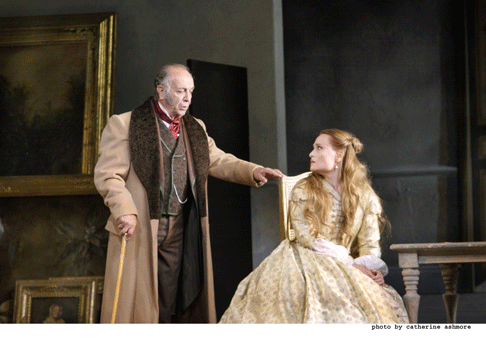 Marina Poplavskaya as Violetta and Leo Nucci as Giorgio Germont
Marina Poplavskaya as Violetta and Leo Nucci as Giorgio Germont
Given the sheer loveliness of the Eyre production, few will complain. For those for whom going to the opera is primarily a social ritual, a resplendent, old-fashioned La Traviata is about as good as it gets, “all champagne and tears”, as Henry James said of Dumas’s play — with gorgeous music. For newcomers to opera, or for those for whom going to an opera is perforce a very occasional treat, it provides just about everything that the popular imagination associates with (and expects from) the art form, and is as close to a guaranteed good night out as the Royal Opera House can offer without losing critical respectability. And though historically-informed opera lovers may reasonably feel that a subject shockingly modern and morally disturbing in the mid-1800s shouldn’t feel quite so nostalgic and comfortable a century and a half later, the majority of them would vote against the sort of “updating” that might make La Traviata controversial today. Altogether the only grumbles are likely to come from those, like the present reviewer, who would like to see the operatic repertoire expand rather than contract, and who want to explore new dishes rather than being fed familiar fare every season.
Issues of comfort and safe programming apart, it is hard to fault the Eyre production on its own terms. Bob Crowley’s designs are visually superb, avoiding the excessively decorative effect of some Traviatas, and in fact strikingly restrained and intimate (only in the last act — poignantly — is the full expanse of the stage exploited to evoke Violetta’s awful loneliness). Time and again the position of the different elements on stage seems to have been planned with the same sort of feeling that Vermeer brought to his paintings. The absence of anything that might appear remotely haphazard lends a classic air to the spectacle, which with the nineteenth-century costumes and settings enhances the sense of deep familiarity that the production breathes: the audience is effectively asked to sit back and relax, to luxuriate in a work already well known, but only now revealed in its definitive form.
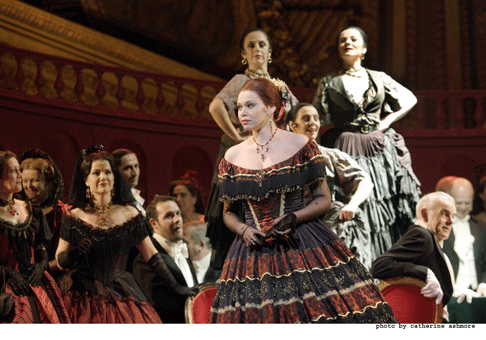 Loira Grodnikaite as Flora
Loira Grodnikaite as Flora
The latest incarnation of Violetta is Marina Poplavskaya, who has been singing the role for several years, and has reported more than once how much she enjoys it. Though not the sort of woman Dumas described, she is physically very convincing in the part: tall, slender, pale, with the sort of enigmatic expressions Dante Gabriel Rossetti loved to paint. She was a commanding presence in the first act, with little — too little for me — hint of the emotional vulnerability to come. The final scene was a technical triumph, but there was a lack of emotion in it, and it was not nearly as moving as it can be. Perhaps it was just a matter of getting into the mood, or of needing the shadows to gather, for in the later acts Poplavskaya was wonderful, her acting and singing beautifully coordinated, and the emotional climaxes very affecting. James Valenti was less satisfying as Alfredo. He seems designed by nature for more heroic roles, and displayed little of the childish petulance and naiveté that seems to me central to the character. He was simply not very interesting, and sometimes appeared to be merely going through the paces.
In sharp contrast Leo Nucci was a staggeringly good Germont in an understated but completely assured and believable interpretation of the role. His voice may have been a little abrasive, especially at first, but that is dramatically appropriate, and he was able to inject a sort of hypnotic precision into the articulation of his words that would have broken down a stronger woman than Poplavskaya’s Violetta. He didn’t seem cruel or sadistic; just horribly certain. Perhaps the greatest tribute that can be paid Nucci is to say that he drew out the best in Poplavskaya. In the scene between them the tension was almost unbearable, and for this reviewer at least it was the highlight of the evening. The succeeding scene, between Poplavskaya and Valenti, was light relief by comparison, and there was an almost palpable sense of collective relaxation in the theatre.
Critics are paid to point score. It would be churlish not to note that the vast majority of the audience seemed pleased with everything and burst into applause at almost every opportunity. The well-tested production is strong enough to carry an uncommitted performance or two, if there is a good Violetta, and as long as it fills the house it can be assumed that it will continue to be revived for the indefinite future. If the economic downturn significantly worsens perhaps there will be a reaction against such beautiful escapism, and operas foregrounding economic struggle will come to capture the Zeitgeist better. But as long as a significant minority of the population is able to splash out on luxuries, and opera programmes carry adverts for Rolex watches and designer jewelry, Violetta, with her reckless living and spending, may continue to personify the very idea of opera at Covent Garden.
David Chandler
image=http://www.operatoday.com/LA-TRAVIATA-2498ashm_025---.gif image_description=Marina Poplavskaya as Violetta and James Valenti as Alfredo [Photo © Catherine Ashmore / ROH] product=yes product_title=Giuseppe Verdi: La Traviata product_by=Violetta Valéry: Marina Poplavskaya; Alfredo Germont: James Valenti; Giorgio Germont: Leo Nucci; Baron Douphol: Robert Poulton; Doctor Grenvil: Richard Wiegold; Flora Bervoix: Liora Grodnikaite; Marquis D'Obigny: Jeremy White; Gastone: Ji-min Park; Anina: Sarah Pring; Guiseppe: Neil Gillespie. Orchestra and Chorus of the Royal Opera House. Conductor: Jan Latham-Koenig. Original Director: Richard Eyre. Revival Director: Harry Fehr. Designs: Bob Crowley. Lighting: Jean Kalman. Movement: Jane Gibson. Royal Opera House, London, 6th October 2011. product_id=Above: Marina Poplavskaya as Violetta and James Valenti as AlfredoAll photos © Catherine Ashmore / ROH
Mahler 8, Royal Festival Hall
(reviewed here, with Das Lied von der Erde), I could not believe that the Eighth would prove worse. It did — considerably so.
The ‘Veni, creator spiritus’ opened in strong, muscular fashion, yet ominously, not only was it metronomic but one could hear every beat, just as in the previous concert. Then there came an extraordinary slowing down, or rather grinding to a halt and staying there, for the entry of the soloists, who, cushioned by a Philharmonia Orchestra reduced for some time to the level of mere accompaniment, sounded more like a Verdi ensemble than voices in the heavenly firmament. The solo voices, moreover, were weirdly positioned: not just in the sense of being behind the orchestra (though raised), but also placed antiphonally at the uppermost two corners of the stage, as if the conductor or management were worried where co-educational singing might lead. The soloists coped variably: Stefan Vinke’s voice stood out, sometimes for better, sometimes for worse, amongst the men, whilst Sarah Connolly proved strongest from the opposing camp. Sally Matthews often sounded strained — though who would not at such a tempo? — whilst Ailish Tynan occasionally contributed an unpleasant edge to proceedings. Even when the pace sped up dramatically, only rapidly and arbitrarily to slow a little later, there was no sense of what any of the words, let alone the music, might mean. It all sounded very hard work, certainly not ecstatic, or even joyful. Whilst the Philharmonia played well in purely technical terms, the orchestra had forced upon it, especially during the development section, an inappropriately fierce attack, a fair aural reflection of Maazel’s stabbing beat. Even string pizzicato sounded as though it might slice one’s hand off. A painful horn fluff in the lead up to the double fugue can be readily forgiven, but the vulgarity with which Maazel directed the brass thereafter cannot: even Solti would surely have blanched at such a loud, brash, artificially ‘exciting’, indeed deafening, noise. And so it went on and on, recapitulation without end.
The Introduction to the second part took us back to the painful audible micromanagement of the Tenth’s ‘Adagio’: every subdivision of every beat bludgeoned into the collective consciousness, every note a thing-in-itself, apparently unconnected to any other, everything taken very, very slowly. There was no sense of line, let alone of landscape — and that in this most extraordinary of aural canvases. It felt like an unpleasant visit to the dentist rather than a view of the forest, let alone a voyage into a world of metaphysics. Though the strings sounded resplendent here, one could only regret the sad waste of their talents. Later on, it became increasingly apparent that, the skill of the players notwithstanding, both orchestra and hall were simply too small. In a decent performance, that might have mattered more.
Back, then, to the slow progress of the second part. The chorus — and there was little or no fault to find in any of the choral singing, always impressive in tone and heft — entered to the most rigid of conducting, as if at rehearsal speed. When Pater Ecstaticus responded, at something akin to a reasonable tempo, that inevitably sounded disconnected from what had gone before. Stephen Gadd, a late replacement for Brindley Sherratt, sounded somewhat threadbare as Pater Profundus: whatever his vocal type (he was listed as a baritone), ‘profundus’ was not the first description to come to mind. Tempi continued to veer arbitrarily, though more often than not they continued to be eked out, sub-division of beat to next sub-division, a test of endurance that did not quite correspond with my understanding of the work. The Mater Gloriosa seemed less to ‘float’ into view than to crawl. He-si-tant-ly.
Again, the soloists proved a mixed bunch. Vinke’s intonation wavered, which is perhaps putting it mildly. (His voice seems to have deteriorated markedly since the first occasions I heard him in Leipzig, where he truly seemed a new Heldentenor hope.) Connolly again proved the most interesting and vocally refulgent of the women, assisted by baleful trombones, which, in a rare moment of musical insight, seemed to transport us back to the Second Symphony. Anne-Marie Owens, however, was tremulous, and blurry of diction. Ailish Tynan proved bizarrely lacking in purity of tone: an impetuous Gretchen is as bad an idea as it sounds. The first syllable of ‘Hülle’ (as in ‘der alten Hülle sich entrafft’) varied between at least three, probably more, different pitches. As for her closing attempt to present Gretchen as diva, one can only respond wearily that that is not quite what Mahler, let alone Goethe, had in mind. Sarah Tynan, however, delivered her lines with palpable, winning sincerity from one of the boxes.
Immediately after those words from the Mater Gloriosa’s, there came, sadly, the only moment with true power to disconcert, to trouble. An unfortunate double bass player fell from her chair and apparently knocked over her instrument, having to be helped from the stage by other members of her section. It was a highly unnerving accident, but the show, alas, went on. Whatever redemption might be, Maazel’s performance lay beyond it. The conclusion to the ‘Chorus Mysticus’, it will not surprise anyone to learn, was dragged out mercilessly, quite negating occasional signs of life at its opening.
I am not someone who usually notes, or indeed notices, durations of performances, but there was something of a discrepancy between the programme’s anticipated timing (eighty minutes) and a 7.30 p.m. concert, which, whilst admittedly starting six or seven minutes late, came to an end slightly after 9.15. The first movement alone must have lasted half an hour. Slow tempi can often be revelatory: consider Klemperer. And then try not to consider Maazel. Nevertheless, the moment Mahler was finally put out of his misery, some members of the audience began to holler loudly and rose to their feet. It was time to catch the bus home.
Mark Berry
image=http://www.operatoday.com/Mahler_1907.gif image_description=Gustav Mahler c. 1907 [Color enhanced photo by Armando Bravi courtesy of International Gustav Mahler Society] product=yesGustav Mahler: Symphony no.8 in E-flat major. product_by=Sally Matthews (soprano, Magna Peccatrix); Ailish Tynan (soprano, Una pœnitentium); Sarah Tynan (soprano, Mater Gloriosa); Sarah Connolly (mezzo-soprano, Mulier Samaritana); Anne-Marie Owens (mezzo-soprano, Maria Ægyptiaca); Stefan Vinke (tenor, Doctor Marianus); Mark Stone (baritone, Pater Ecstaticus); Stephen Gadd (baritone, Pater Profundus). The Choirs of Eton College (precentor and director of music: Tim Johnson). Philharmonia Voices (chorus master: Aidan Oliver). Philharmonia Chorus (chorus master: Stefan Bevier). BBC Symphony Chorus (chorus master: Stephen Jackson). Philharmonia Orchestra. Conductor: Lorin Maazel. Royal Festival Hall, London. Sunday, 9 October 2011. product_id=Above: Gustav Mahler c. 1907 [Color enhanced photo by Armando Bravi courtesy of International Gustav Mahler Society]Ten Years of Celebrating Song: Oxford Lieder Festival 2011
It began as a labour of love. Ten years ago, Sholto Kynoch, now Artistic Director and driving force behind Oxford Lieder, was a postgraduate student working with Malcolm Martineau. “It started by accident”, he says “I just wanted to play Schubert with friends.” That first year, they performed just the three Schubert cycles. Schubert remains at the heart of the Oxford Lieder Festival. There are plans for a huge, ambitious Schubertiade in 2014.
The first weekend of this tenth anniversary year is devoted to Schubert, Every song from Die schöne Müllerin D. 795 to the magnificent Der Hirt auf dem Felsen D. 965 on the opening evening, Friday 14th October, with Graham Johnson, Brigid Steinberger and Joy Farrell (clarinet).
Oxford Lieder does things in depth. There’s a two day series of workshops, talks and four concerts considering “The Wagner Effect” on art song, with particular emphasis on the songs of Franz Liszt and Hugo Wolf. Very good speakers, including Amanda Glauert, whose “Hugo Wolf and the Wagnerian Inheritance” is a classic. Oxford Lieder is in the process of recording the complete Hugo Wolf song output. Volumes 1 and 2 ( the Mörike songs) are already available through Stone Records. The discs are unusual in that they feature four different singers (Sophie Daneman, Anna Grevelius, James Gilchrist, Stephan Loges and Sholto Kynoch at the piano) and were recorded live last year in the Holywell Music Room, with its perfect, intimate acoustic. This year, the concert on 18th October is being recorded and will feature Wolf’s earliest work and his settings of Keller and Ibsen.
An intensive three day series on Swedish Song follows from 21st October. Oxford Lieder has a tradition of presenting Scandinavian music. This year, Miah Persson, Anna Larsson, and Håkan Vramsmo will be singing Rangström, Sjögren, Nystroem and Grieg . There’ll also be premieres of two new works, by Tobias Brostöm and Carin Bartosch Edström. Håkan Hagegård will present one of two masterclasses in Swedish song and be on hand for a screening of Ingmar Bergman’s film of Mozart’s The Magic Flute, in which he sang Papageno.
Although the Oxford Lieder Festival operates on a shoestring, it makes a point of supporting new work. This year’s composer in residence is Charlotte Bray, whose work will feature in three separate concerts, culminating with a new song cycle specially commissioned by Oxford Lieder, to be premiered on 27th October by Roderick Williams. There’s a composition workshop on the same day, led by Professor Robert Saxton.
The Oxford Lieder Festival is supported by many major singers, like Wolfgang Holzmair, Florian Boesch, Sir Thomas Allen, Sarah Connolly, Dame Felicity Lott, James Gilchrist and Roderick Williams, all of whom will be giving keynote recitals.
Fundamental to the Oxford Lieder ethos, however, is the idea of nurturing new talent. Each year there’s a two week residential masterclass for pairs of singers and pianists. developing practical performance skills. Participants attend the whole Festival, so it’s intensive, but rewarding. They also give their own concert. There’s also a Young Artists Platform which gives awards and opportunities for singers and pianists to perform year round. This concept of practical performance means a great deal to Sholto Kynoch. He loves “the buzz between performer and audience, that allows you to put across what you want to with the music”. He adds, with enthusiasm, “That two-way dynamic is something I’ve tried very hard to get at the Festival, and I think it’s one of the festival’s strongest features.”
Most concerts take place in the Holywell Music Room, where Mozart and Haydn once performed. It’s perfect for Lieder because its size allows particularly close communication between performers and the audience. For many that intimacy might be intimidating, but Kynoch’s personality encourages performers to give of their best. He gives over 70 concerts a year, as pianist, but he’s also a charismatic organizer. The “Oxford Lieder Family” atmosphere, involving both audience and performers, is part of its unique charm. Everyone is valued, whether a big star or a non-professional. There are even workshops for amateurs and part-song recitals in the street to attract people who don’t yet realize how much fun singing can be.
For more details, please see the Oxford Lieder Festival website.
Anne Ozorio
image=http://www.operatoday.com/Holywell_Music_Room.gif image_description=Holywell Music Room [Source: Wikipedia] product=yes product_title=Ten Years of Celebrating Song: Oxford Lieder Festival 2011 product_by=By Anne Ozorio product_id=Above: Holywell Music Room [Source: Wikipedia]October 10, 2011
Così fan tutte, Los Angeles
Its libretto was written by Lorenzo Da Ponte, who despite the fact that he was both a priest and a professor at Columbia College (not at the same time) had attained notable fame in his youth for licentiousness. The opera’s title means “all women are like that” and its subtitle “La scuola di amante” means “school for lovers.” Ostensibly an education in love, in Da Ponte’s and Mozart’s hands the opera’s lesson is that all women are fickle.
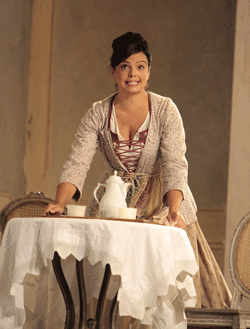 Roxana Constantinescu as Despina
Roxana Constantinescu as Despina
Guglielmo and Ferrando, two handsome young men engaged to sisters Fiordiligi and Doraballa, swear to Don Alonso, their old philosopher friend that the girls will be faithful to them forever. The cynical Alonso’s assertion that the girls will take new lovers in less than 24 hours if the men follow his instructions, results in a bet. Don Alonso elicits the help of the young women’s maid servant, Despina. The women are told that their heroes have been called to war, and shortly thereafter the two men disguised as “Albanians” appear to declare their passionate, (and sometimes comical) love — but to each other’s girl. Torn by conscience and tempted by the joys of love, the girls suffer a few pangs, but soon give in, each to her sister’s fiancé, whereupon to their mortification, the treacherous scheme is revealed. Then somehow — maybe Mozart didn’t like unhappy endings — there’s a cheerful sextet in which all the characters agree, “let’s get over this and look at the sunny side of things.” But who did the girls go home with? Their first lovers or their second? Mozart and Da Ponte don’t tell us! And if women study this “school’s” lesson a little deeper, they may wonder, “Are all fiancés like that?”
This is an attractive well-matched cast. Happily, the two male leads resemble each other enough to muddle their identities while in disguise, so there’s no little worm to gnaw at your aching-to-believe brain saying, “How could the girls not recognize them?” The production that Nichols Hytner, originally created for Glyndebourne with its tawny sets and blazing blue Neapolitan skies are crisp and elegantly restrained.
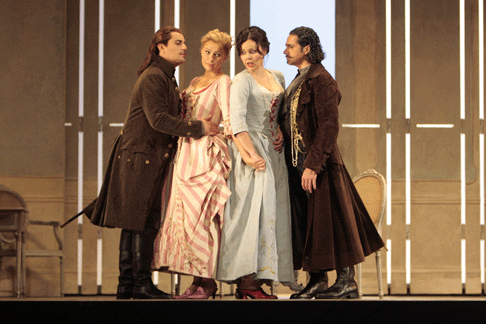 Saimir Pirgu as Ferrando, Ruxandra Donose as Dorabella, Aleksandra Kurzak as Fiordiligi and Ildebrando D’Arcangelo as Guglielmo
Saimir Pirgu as Ferrando, Ruxandra Donose as Dorabella, Aleksandra Kurzak as Fiordiligi and Ildebrando D’Arcangelo as Guglielmo
But it’s the music that triumphs. Maestro Conlon personally chose the cast of European singers for their facility with Italian recitative, as well I am sure, for the quality of their voices. Bass Lorenzo Ragazzo, delivered a cheerful, perhaps not cynical enough Don Alfonso. Bass-baritone, Ildebrando D’Arcangelo as Guglielmo, pranced agilely when required — what a “Mefistofole” he would make! Saimir Pirgu’s Ferrando’s “Un’aura amorosa”and Aleksandra Kurzak’s “Come scoglio” hit their difficult marks. While the tessitura of Fiordiligi’s role unquestionably requires a soprano, the roles of Dorabella and Despina, here mezzos Ruxandra Donose and Roxana Constantinescu, respectively, are not as clearly defined in terms of range and can be sung by sopranos. Most frequently, it is Despina (think saucy Susanna in the Marriage of Figaro) who is cast as a soprano. Constaninescu, however, is perhaps too young to make a properly worldly-wise and arch Despina. The similarity of her sound to Donose’s Dorabella’s reduced the impact of her role and had me wishing for a bright soprano sound.
The essence of this Così is the sense of ensemble: the balance between orchestra and voice, and the clearly visible rapport between the singers and Maestro Conlon. When Conlon stretched past his score with this arms high over his head, and looked directly at his singers, it seemed as if the baton in his hand was a magic wand eliciting spontaneous song.
And did they all have fun with their curtain calls!
Estelle Gilson
image=http://www.operatoday.com/coz6063.gif image_description=Lorenzo Regazzo as Don Alfonso [Photo by Robert Millard courtesy of LA Opera] product=yes product_title=W. A. Mozart: Così fan tutte product_by=Ferrando: Saimir Pirgu; Guglielmo: Ildebrando D’Arcangelo; Don Alfonso: Lorenzo Ragazzo; Fiordiligi:Aleksandra Kurzak; Dorabella: Ruxandra Donose; Despina: Roxana Constantinescu. Conductor: James Conlon. Original Production: Nicholas Hytner. Director: Ashley Dean. product_id=Above: Lorenzo Regazzo as Don AlfonsoAll photos by Robert Millard courtesy of LA Opera
October 7, 2011
Carmen, Philadelphia
The grand opera version requires a voluptuous dramatic mezzo voice with a menacing flash of steel and booming chest tones. This musical style lends itself to a dramatic portrayal of the gypsy as a dangerous, snarling man-eater—a tigress capable of drawing a knife on Don José, had he not drawn one on her first. In the end, this Carmen seeks to seduce us by overwhelming us. This ideal is approximated by Grace Bumbry, Maria Ewing, Marilyn Horne, and, though she is always unique, Maria Callas.
The second type of Carmen, which reflects Georges Bizet’s roots in the French opéra-comique, calls for a smaller, more lyrical voice with a gentler timbre, smooth projection, and precise attention to delicate inflections of language and line. On this view, the gypsy is not a tigress but (as the libretto says of love) a bird. This Carmen is less blatantly threatening than her dramatic twin, yet her flirtatious, exotic, distantly self-absorbed manner poses just as great a danger to our hearts. She seduces not by overpowering but by mesmerizing. This approach is taken by Victoria de los Angeles and Teresa Berganza.
Most who sing Carmen these days aspire to the dramatic ideal, but Rinat Shaham, Philadelphia’s choice, fits the lyric model. Shaham is a Haifa-born mezzo who trained at the local Curtis Institute, debuted with the company as Zerlina in 1994, and has sung the role of Carmen to acclaim in theaters across the world, notably Glyndebourne. Shaham’s voice is not enormous, but it is focused, possesses an attractive sheen, and is articulated very evenly top to bottom. She phrases with understatement, a virtue lamentably absent among modern-day Carmen’s. Some quieter moments were memorable: the interposed “L’amour” in the “Toreador Aria” comes to mind, as does the Act III (“card”) trio, which suits her lovely low notes and contemplative manner. With black curls, flashing eyes, and slender curves popping out of the corset all Carmen’s seem to wear these days, she cuts an alluring figure on stage—and on posters throughout Philadelphia.
The result was in many respects agreeable. Absent throughout, however, were musical-dramatic subtleties essential for a lyric portrayal of Bizet’s gypsy to aspire to artistic greatness: the delicate use of glissando, rubato, rhythmic accent, idiomatic diction, timbre and color, and phrasing through the line. The “Habanera” was deadened by breathiness and an unyielding tempo, whether the fault of the conductor or singer. Shaham seemed to focus in the “Seguidilla” more on movement than voice, concluding with a needlessly strident cry. In the final scene, Shaham did not—vocally speaking—push herself to the edge of either desperation or fatalism. Without the extra interpretive effort, the performance seemed much blander than this artist’s potential, let alone the very best historical counterparts.
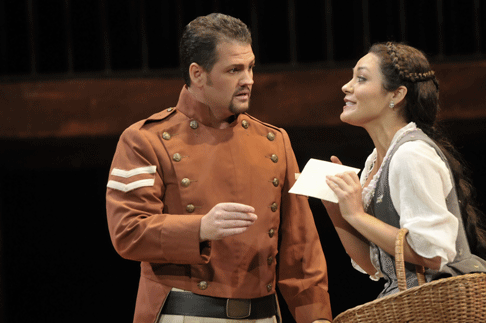 David Pomeroy as Don Jose and Ailyn Perez as Micaela
David Pomeroy as Don Jose and Ailyn Perez as Micaela
Ailyn Pérez, the young Academy of Vocal Arts-trained soprano, posed a striking contrast as Michaëla. Pérez’s voice, pleasant and precise if slightly metallic, is no match for Shaham’s. Moreover, the plot turns in part on the obvious fact that neither the personality or music of Michaëla, the nice god-fearing girl from the country, can match that of Carmen. Yet Pérez imbued every line with creative imagination, especially the famous aria, where subtle dynamics, precise diction and firm sense of the where it was all going conjured up the evening’s most memorable moments and greatest applause.
Canadian tenor David Pomeroy made a solid Don José. Though his voice lacks the ring, precision or the sweetness some bring to the part, he phrased with intelligence and precision, improving as the night went on, and he looks the part of a proud, if unimaginative, Basque. Another young Curtis alum, Jonathan Beyer, cut an imposing figure as Escamillo, though his voice, though well-produced, is a bit less grand—a problem in a part where one wants to be overpowered by testosterone. Well-trained if uneven young voices, mostly the products of local institutions, appeared in the smaller roles.
The conducting by Philadelphia’s music director, Bergamo-born Corrado Rovaris, displayed what I have come to think are his characteristic strengths and weaknesses. He imbues performances with energy. The music moves along, and achieves a certain excitement in hard-driving, straight-forward passages—as in the famous Prélude. Yet the result can sound unimaginative where the score calls for flexibility, ambiguity, or shifts in mood.
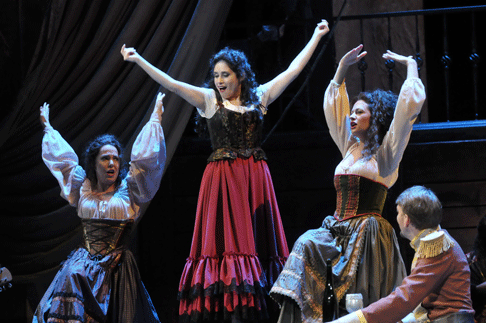 Rinat Shaham (center) as Carmen, Tammy Coil (left) as Mercedes and Greta Ball (right) as Frasquita, with Jeremy Milner as Zuniga
Rinat Shaham (center) as Carmen, Tammy Coil (left) as Mercedes and Greta Ball (right) as Frasquita, with Jeremy Milner as Zuniga
Visually, the production by Allen Charles Klein cleaves to a formula that has helped to make opera in Philadelphia popular and financially solvent: a grand unit set in traditional style, accessorized for each act with different props, costumes, and lighting—the latter sometimes tending toward slightly garish blues and oranges, courtesy of Drew Billiau. Outside of Act I, none of this adds much atmosphere or insight, but the audience seems to enjoy it. The stage direction, by David Gately, follows the formulas of previous productions, but enlivens them with a few fine touches: several suggestions of Carmen as a caged animal and liberty with the libretto, whereby she never finds the second-act castanets, dancing the duet instead with the (usually discarded) pieces of cracked plate.
Andrew Moravcsik
image=http://www.operatoday.com/fullres_2011_09_28_KM1475.gif image_description=Rinat Shaham as Carmen and David Pomeroy as Don Jose [Photo by Kelly & Massa Photography courtesy of Opera Company of Philadelphia] product=yes product_title=Georges Bizet: Carmen product_by=Click here for cast list. product_id=Above: Rinat Shaham as Carmen and David Pomeroy as Don JoseAll photos by Kelly & Massa Photography courtesy of Opera Company of Philadelphia
October 6, 2011
English National Opera's The Marriage of Figaro - video
By Tom Service and Alex Healey [Guardian, 6 October 2011]
Director Fiona Shaw tells Tom Service about her take on Mozart's The Marriage of Figaro at the Coliseum in London. Shaw has previously directed ENO productions of Vaughan Williams' Riders to the Sea and Henze's Elegy for Young Lovers
October 5, 2011
Menotti in German
Translated into German and filmed in the standard grainy black-and-white of the day, Die alte Jungfer und der Dieb and Das Medium benefit from sharp direction (by a young Otto Schenk) and expert performances. The scale of one’s enjoyment, of course, will be determined by the depth of one’s appreciation for the operas of Gian Carlo Menotti — and “depth” is probably not the term of choice in that context.
In a bonus feature interview, recorded at the time of the broadcasts, Schenk calmly argues for the merits of Menotti’s work, claiming they show a “typical American setting” and advocating for the appeal of the music, despite what Schenk calls its “banality” (as the subtitles translate it). Perhaps the original German word has a different connotation, but “banality” seems apt.
With their small casts and domestic settings, the Menotti works seen here are perfect for the TV screen. The Medium in particular seems like a lost episode of The Twilight Zone or Outer Limits, with the odd innovation of sung dialogue. Both operas, however, feel stretched to fill an hour, especially The Old Lady and the Thief. In this supposed comedy (Scheck’s description), a spinster takes in a homeless man, due to her maid’s pleading and the spinster’s own suppressed desire. When the two later hear that a thief is on the loose, they suspect it is their man. In the decidedly un-comic conclusion, the man reveals he is not a thief — and then, with the maid, absconds with the spinster’s most precious possessions, leaving her bereft. This sour piffle gets a better performance than it deserves, in remarkably effective German. Elisabeth Höngen’s Miss Todd, the spinster, achieves real pathos, and Olive Moorfield strikes some sparks as her maid Laetitia. As the supposed thief Bob, Eberhard Waechter shows a little bit of what made him a Don Giovanni worthy of leading the starry ensemble on the famous Carlo Maria Giulini recording. Menotti’s debt to Puccini weighs down almost every bar of music, from the comic fast music right out of the opening to Madama Butterfly (and Menotti seems to acknowledge this by naming a minor character Miss Pinkerton) to the melodic arias. But where Puccini’s music grows in impact with repeated exposure, Menotti’s never develops beyond a superficial appeal.
The Medium serves as a showcase for a soprano “of a certain age,” and Höngen reveals her depth by taking on this role and making it clearly distinct from the spinster. Here she delineates Madame Flora, a bitter woman who leads séances with people who have recently lost a loved one, knowing that their pain and sensitivity will make her clients vulnerable to her cheap effects. A female assistant and Toby, a deaf-mute young male, support her, but when Madame Flora herself feels a cold hand on her throat at the end of a seance, she chases her customers out and collapses in terror. In the extended act two, her paranoia grows, until finally she mistakes Toby, hiding behind a curtain, for a ghost, and shoots him. Before she goes crazy, however, Menotti gives Madame Flora an extended scene of high-octane vocalism, owing quite a bit to Minnie from Fanciulla in act two.
Despite the questionable merit of Menotti, anyone with any nostalgia at all about the early days of TV and live performance should seek out this DVD. Even the interview is a treat, with its bland interviewer sitting at a bare desk before a curtain, asking Otto Schenk to explain the show for the audience. Schenk clearly believes in these works, as the committed acting of his singers indicates. So as a historical document rather than artistic artifact, this DVD gets a recommendation.
Chris Mullins
image=http://www.operatoday.com/ArtHaus_101515.gif image_description=ArtHaus Musik 101515 product=yes product_title=Gian Carlo Menotti: Die Alte Jungfer und der Dieb / Das Medium (Studio Productions, 1961 and 1964) product_by=Die alte Jungfer und der Dieb (The Old Maid and the Thief) — Miss Todd: Elisabeth Höngen; Laetitia: Olive Moorefield; Miss Pinkerton: Hilde Konetzni; Bob: Eberhard Waechter. Vienna Volksoper Orchestra. Wolfgang Rennert, conductor. Historical Studio Production, 1964.Das Medium (The Medium) — Madame Flora: Elisabeth Höngen; Monika: Maria José De Vine; Toby: Nino Albanese; Mrs. Gobineau: Sonja Draksler; Mrs. Nolan: Hilde Konetzni; Mr. Gobineau: Norman Foster. Vienna Volksoper Orchestra. Armando Aliberti, conductor. Historical Studio Production, 1961.
Otto Schenk, stage director. Maxi Tschunko, costume design. Gerhard Hruby, set design. product_id=ArtHaus Musik 101515 [DVD] price=$26.99 product_url=http://www.arkivmusic.com/classical/Drilldown?name_id1=8049&name_role1=1&comp_id=61578&bcorder=15&label_id=6009
Wes Blomster 1929-2011
Wes served as our itinerant reviewer covering events from Jerusalem to Berlin to San Francisco to Minneapolis and elsewhere. Wes particularly enjoyed reviewing new works such as Dead Man Walking, Moby Dick. Grapes of Wrath and Anna Karenina, as well as revivals such as Ghosts of Versailles and Wuthering Heights. He will be sorely missed.
Gary Hoffman
image=http://www.operatoday.com/Wes_Blomster.gif
image_description=Wes Blomster 1929-2011
product=yes
product_title=Wes Blomster 1929-2011
product_by=
product_id=
October 3, 2011
The Inaugural Cambridge Handel Festival: a rosy dawn?
Luckily, there was an alternative to the sweltering pavements and swirling crowds of Freshers Week: the inaugural Cambridge Handel Festival announced its arrival on the period music scene with a weekend of the coolest venues and the most exciting music-making. There is already a well-established Handel “hard core” living in and around the city — the Cambridge Handel Opera Group is well regarded — but it was something of an act of faith on the part of the organisers (Cambridge Early Music) to devote an entire weekend to all things Handelian. It was only towards the end of the two days, after a scintillating final concert of the Violin Sonatas by Adrian Butterfield, that it became obvious that the Festival had not only been an artistic success but had also, most importantly, just about broken-even financially. In this age of straitened budgets, this is no mean feat.
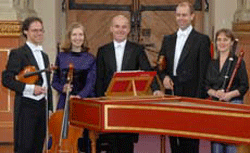 London Handel Players [Photo courtesy of NCEM]
London Handel Players [Photo courtesy of NCEM]
The Festival was an innovative mix of events: a guided walk, talks by Handel experts, specific church services with a Handelian slant, an organ recital by the hugely talented Mark Williams in the chastely-elegant confines of Wren’s Pembroke College Chapel, and both instrumental and vocal concerts which delighted both enthusiasts and casual ticket-buyers alike. The backbone of the Festival was, one would have to say, Laurence Cummings and his London Handel Players who featured not only the deeply satisfying playing of both Adrian Butterfield (violin) and Rachel Brown (flute/recorder) but also accompanied the evergreen Emma Kirkby with great finesse and sympathetic musicianship. This latter concert highlighted arias written for soprano Cecilia Young (later Mrs Arne) by her husband, Lampe and Handel himself and we were treated to some songs rarely heard before: “Pretty Warblers” and “By the rushy-fringed bank” were delightful curiosities, delightfully sung.
Speaking with various other visitors to this Festival it was obvious that the variety of events had been a success, as had been the many interesting and unusual venues. There was a well-produced and informative programme book which both enlightened the newcomer but also informed the confirmed Handelian — for instance, the Fitzwilliam Museum in the heart of the city keeps some manuscript music by the great man which was put on show (with explanatory notes) especially to coincide with the weekend’s events. One can only hope that this most lovely of cities will once again feature the works of Handel and his contemporaries in another such festival: the foundations have certainly been well-laid.
Sue Loder
image=http://www.operatoday.com/Dame-Emma-Kirkby.gif image_description=Dame Emma Kirkby [Photo courtesy of London Handel Festival] product=yes product_title=The Inaugural Cambridge Handel Festival: a rosy dawn? product_by=By Sue Loder product_id=Above: Dame Emma Kirkby [Photo courtesy of London Handel Festival]Controversy over Duluth Festival Opera's "Pocahontas" overflows to tears and curses in Burnsville
By Lisa Steinmann [TC Daily Planet, 3 October 2011]
A scene in Pocahontas: A Woman of Two Worlds has Pocahontas (Linh Kauffman) falling to her knees with outstretched arms, portraying the anguish of a woman who struggles to understand who she is and where she belongs. The poignant moment, moreover, pinpoints the emotional controversy surrounding the opera since it made its Minnesota debut in Duluth on Sept. 22.
October 2, 2011
Eugene Onegin, Los Angeles
Kudos too, for having presenting the work in a production created by the late Stephen Pimlott for the Royal Opera House and the and the Finnish National Opera (more about this later) which, though it sparked discontent at its 2006 London premiere, introduces a new view of the tale.
Whereas Pushkin narrated his lengthy lyrical poem filled with wit, cynicism, and psychological insights, Tchaikovsky and his librettist Konstantin Shilovsky reduced the work to intimate scenes focused directly on their principal characters. In both versions, however, the story is set at a time when rank and status mattered, when women were essentially powerless. Eugene Onegin, the eponymous protagonist (one can’t call him a hero) of the work, is the wealthy neighbor of the widow Larina and her young daughters, Olga and Tatiana. Onegin, who has wandered the world, lives the dissolute life of a Byronic Don Juan, and carries himself with the aristocratic mien of Jane Austen’s Mr. D’Arcy, is introduced to the Larin household by the poet Lensky, in love with Olga. The three woman, attended by a nanny, live as did Elizabeth Bennett, a modest country life. But in this story, it takes only a glance for young Tatiana to fall in love with the elegant Onegin. The same night, unable to sleep, overflowing with passion and impetuosity, she writes a letter to Onegin offering him her heart.
When the two meet the next morning Onegin honorably, but coldly returns the humiliated girl’s letter and rejects her love. Later, bored at a local ball, he flirts with Olga and incenses Lensky to the point where the poet challenges him to a duel Lensky is killed and Onegin returns to his aimless wandering life. When, in Act 3 Onegin and Tatiana meet again, she is the wife of a prince. Now it is Onegin who will write a letter and plead for love. Tatiana first upbraids him for his past cruelty, then confesses that she still loves him. But refusing to renounce her vows, she leaves him alone to his despair. Is this a story of payback, as one reviewer described it? Is it about class and caste? Is it about a country girl’s solid values, set against the nihilism of a sybaritic life? Or does it reflect as many Pushkin scholars believe, the battles raging within Pushkin himself? It should not be surprising to find new interpretations of the work.
Though not a cast well-known to American opera goers, Los Angeles assembled four stellar principals with knowledge of the language and familiarity with their roles, which always brings a a sense of ease to a production. Baritone Dalibor Jenis was a full voiced, if somewhat stiffly mannered Onegin, until the last scene when rejected by Tatiana, jacketless and unkempt, he seemed to me a maddened Don Jose. Oksana Dyka’s role as Tatiana took her in an opposite emotional direction. In voice and manner she made the transition from love starved teen ager to mature woman convincingly. I loved tenor Vsevolod Grivnov’s ringing top voice as Lensky’s but sometimes I think I love every tenor as Lensky. Mezzo-soprano Ekaterina Semenchuk sang Olga, and Margaret Thompson, her mother, Larina with assurance and ease. There were three young American artists in the cast. Ronnita Nicole Miller as Filipievna, the nanny, has a rich voice wonderfully under control. James Cresswell sang Prince Gremin’s aria with magnificent sonority and hit the low notes, but still lacks that “innerness” that brings subtlety and shading. Keith Jameson was a silky voiced Trinquet.
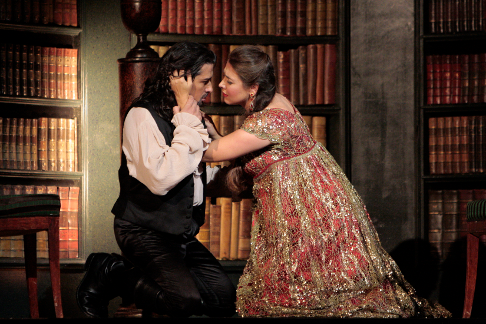 Dalibor Jenis as Onegin and Oksana Dyka as Tatiana
Dalibor Jenis as Onegin and Oksana Dyka as Tatiana
In the emotion-filled dramatic scenes that Tchaikovsky set, not only the characters, but his music speak directly to our hearts. Conductor James Conlon led the orchestra in a pulsing, radiant performance.
Pimlott’s intelligent production deserves a review of its own despite some incomprehensible stagings: why Tatiana writes a letter bursting with passion while bent over on the floor, I’ll never know. And why the glittering third act “polonaise” is performed before a scrim depicting death, remains a mystery to me. Suffice it now to say that with this production Pimlott introduces us to Pushkin’s narrative viewpoint. Aided by Antony McDonald’s sometimes outlandish costumes and Peter Mumford’s always dramatic lighting, he gives us something of Pushkin’s distant view of his characters by staging the action as though painterly images set within a frame.
One last word about Tchaikovsky’s music. Tatiana, Lensky, Gremin and Onegin have the four great arias of this opera. Leaving the theater, I could recall snatches of the first three, all of which declare love, but not of Onegin’s. His is the one about rejection.
And one other last word to thank Placido Domingo and the Opera Company for including a touching tribute to Salvatore Licitra in its program.
Estelle Gilson
image=http://www.operatoday.com/eon8075.png image_description=Vsevolod Grivnov as Lensky and Ekaterina Semenchuk as Olga [Photo by Robert Millard for LA Opera] product=yes product_title=Pyotr Ilyich Tchaikovsky: Eugene Onegin product_by=Eugene Onegin Dalibor Jenis; Tatiana: Oksana Dyka; Lensky: Vsevolod Grivnov; Olga: Ekaterina Semenchuk; Larina: Margaret Thompson;Filipievna: Ronnita Nicole Miller; Gremin: James Cresswell; Trinquet:Keith Jameson. Orchestra and chorus of the Los Angeles Opera. Conductor: James Conlon. Original Production: Steven Pimlott (deceased). Original Director: Steven Pimlott. Director: Francesca Gilpin. Scenic and Costume Designer: Antony McDonald. Lighting Designer: Peter Mumford. Original Choreographer: Linda Dobell (deceased). Choreographer: Ulrika Hallberg. product_id=Above: Vsevolod Grivnov as Lensky and Ekaterina Semenchuk as OlgaAll photos by Robert Millard courtesy of LA Opera
